In this post, I’m taking you on a trip to Syracuse to explore the ancient wonders and coastal charms of Sicily. However, this city on the island’s southeastern coast isn’t just for history buffs! Its markets burst with local flavors while its sun-soaked piazze invite leisure’n’pleasure. And as the sun slowly sets, bathing the historic buildings in a burning golden light, the coast of Syracuse shines in its radiant splendor, waiting for you with a delicious dinner by the sea.
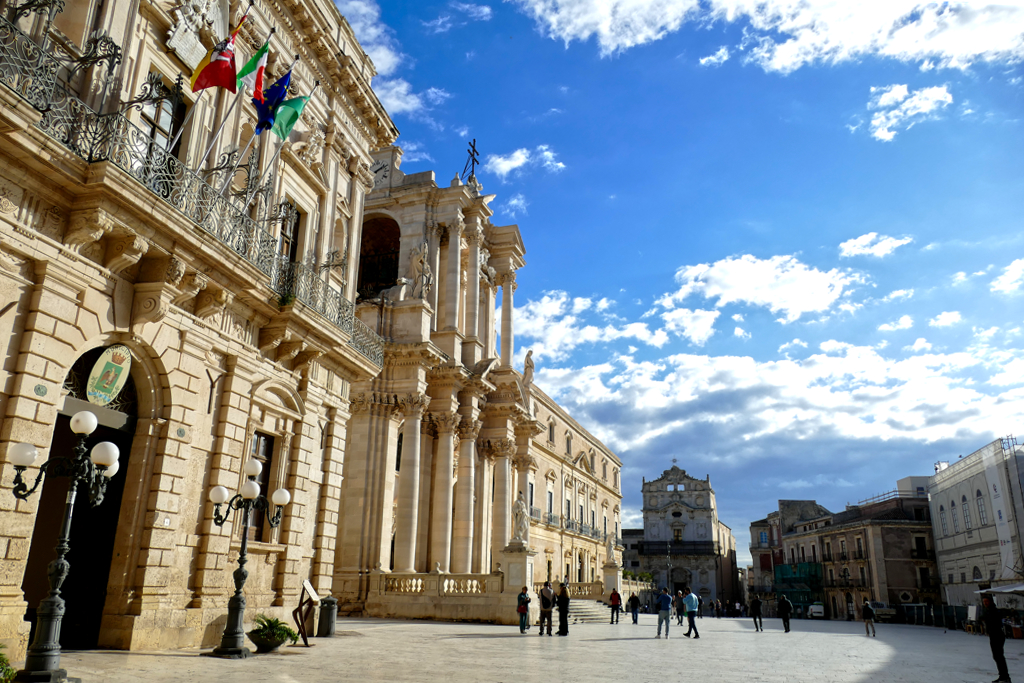
Few places can match Syracuse’s ability to captivate both mind and heart. It’s not just a destination—it’s a journey through time and an invitation to experience Italy’s legendary dolce vita at its most enchanting.
Syracuse is Sicily at its finest!
Benvenuti a Siracusa
Syracuse, or Siracusa in Italian, is Sicily’s fourth largest city and is located at the southeastern tip of the island. It is particularly known for its rich and eventful heritage. However, I was in Syracuse to brush up on my Italian and stayed for two weeks. Even though I felt very comfortable, because I love finding my way around better and better when traveling after the initial orientation phase and slowly even feeling a little at home, I dare to say that the most important and beautiful thing about the city is has to offer, can also be seen in a much shorter time. If necessary, one day can be enough, because Sicily has so much beautiful things to offer.
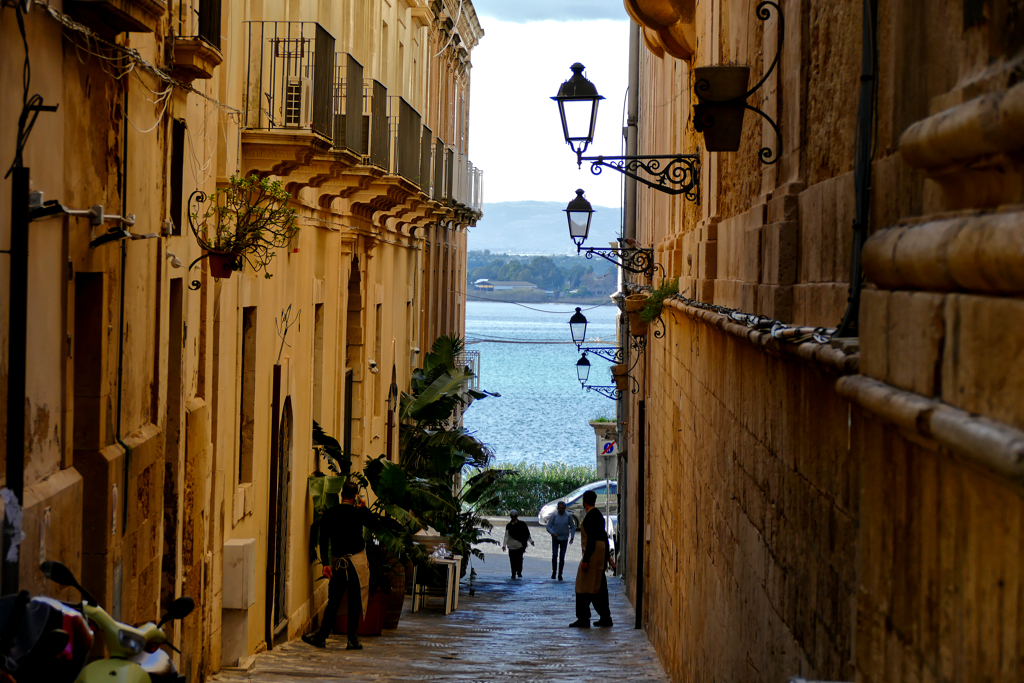
The modern city of Syracuse is relatively unspectacular. Relaxed and friendly, but generally speaking, nothing to write home about. In addition to an archaeological park, home to the stunning Greek Theatre and the so-called Ear of Dionysius, you’ll also find what I think is the second-ugliest church in the world right there. Hence, if you’re into monstrosities, you’ll be thrilled.
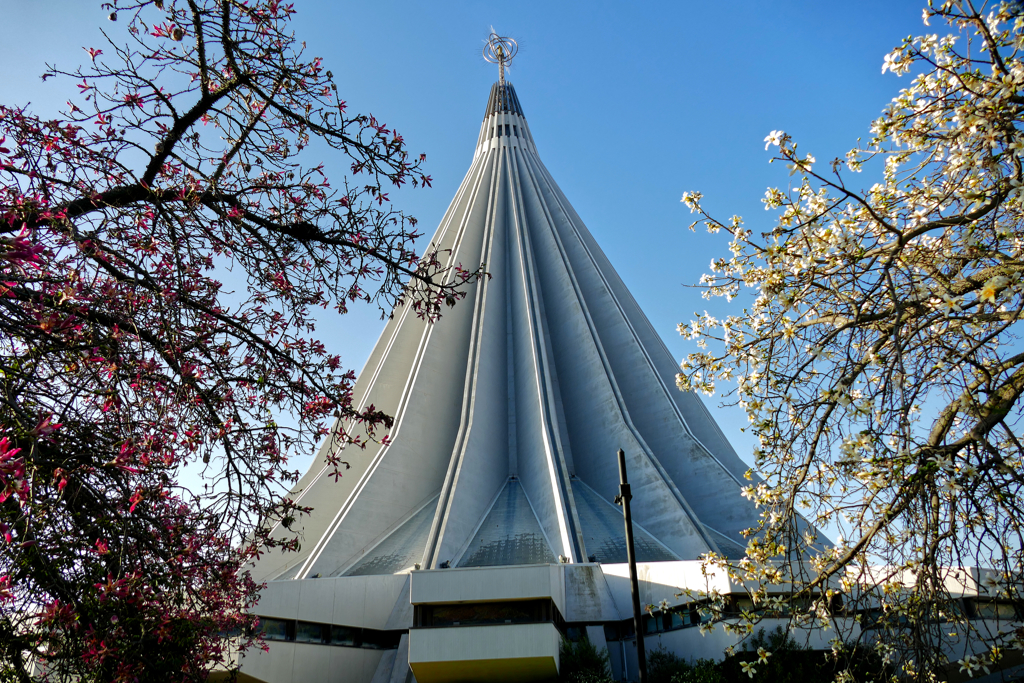
However, most visitors are mainly drawn to the Ortigia peninsula off Syracuse. Here you can meander through a dazzling labyrinth of narrow streets lined with baroque palaces and ancient ruins, all that surrounded by the sparkling Ionian Sea. Every corner whispers stories of Greek philosophers, Roman emperors, and medieval knights.
In the following guide, I will introduce you to a couple of sites in the center that you should visit. Then we rush straight to Ortigia to get lost in the network of alleys and feel the atmosphere of past glory.
Short Tour of the City of Syracuse
I always find it fascinating to see archaeological sites that are thousands of years old in the middle of a modern city. I think that we value far too little the fact that we can still walk along paths that the ancient Greeks and Romans walked upon and be able to admire stone witnesses to such a distant past. With my mouth open and my heart beating fast, I stood in places like the Acropolis in Athens and in the Colosseum in Rome and couldn’t believe my eyes.
What an incredible privilege!
There are also a number of amazingly well-preserved archaeological sites in Sicily, and one of the best-known is right in the middle of the new town of Syracuse.
Parco Archeologico della Neapolis
The Parco Archeologico della Neapolis includes a Greek theater, a Roman amphitheater, the sanctuary of Apollo Temenites, the altar of Hieron II, various latomies, and the Grotticelle necropolis. The site was opened in 1955 and is located in the northwestern part of the city.
One of the most famous highlights is the so-called Ear of Dionysius. This grotto got its name because of its shape, which resembles a human ear.
Another substantial feature is the Greek theater. It was carved out of the rock and dates back to the 5th century BC. The Romans later rebuilt the theater significantly. They also built a Roman amphitheater in the 3rd century, which has survived to this day. In fact, it was one of the largest in the Roman Empire. Above the theater was the sanctuary of Apollo Temenites, of which only remains remain.
Sarcophagi from Syracuse and Megara Hyblaea from the 4th and 3rd centuries BC line the trail to the theater. In the middle of this trail is the Grotta del Ninfeo. In the Spanish era, the grotto water-powered several water mills, one of which survives to the west of the theater. Other smaller grottos along the grave road are of Christian origin.
The Grotticelle necropolis, located west of the Latomia di Santa Venera at the end of the park, dates back to the 7th century BC. Christ. There is an elaborately designed grave site here, known as the Tomb of Archimedes. In reality, however, it is a columbarium from Roman times.
The archeological park can be visited every day for a general entrance fee of 14 €uros. However, the opening hours vary by season, hence, you should definitely check out their website to plan your visit.
Museo Archeologico Regionale Paolo Orsi
Another must-see for history and archeology lovers is the Museo Archeologico Regionale Paolo Orsi. It is one of the most important archaeological museums in Italy and illustrates the immense cultural diversity and historical importance of Sicily in ancient times. It was named after Paolo Orsi, one of the most important archaeologists of the early 20th century, who led many important excavations in Sicily and had a decisive influence on archaeological research in the region.
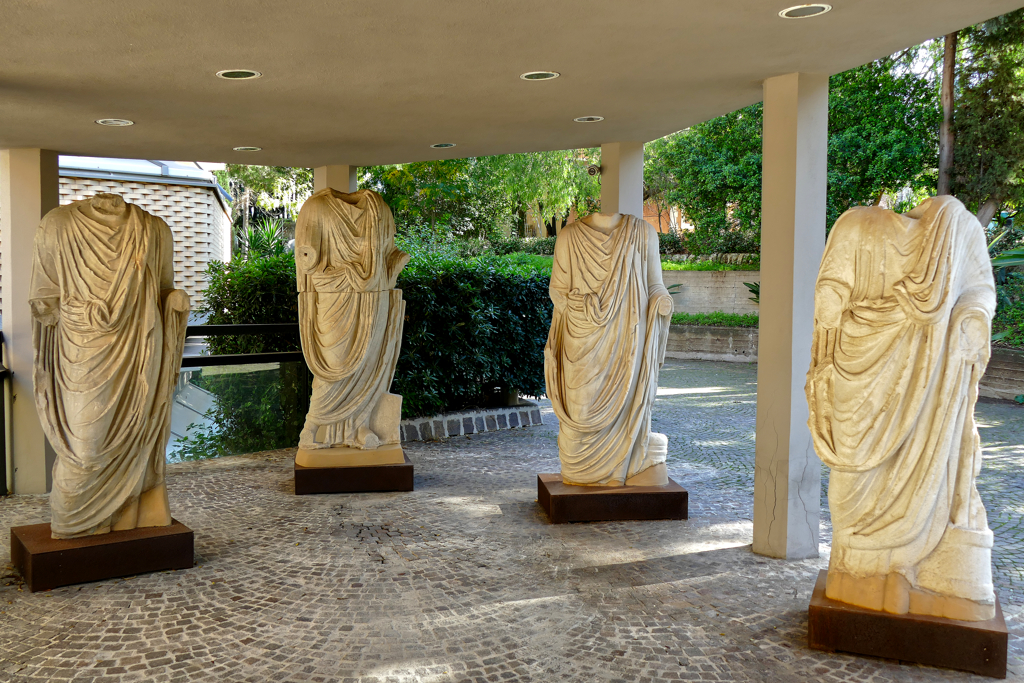
The museum was opened in 1988 and is part of the extensive Villa Landolina park. It is housed in a modern, functional building specifically designed for the presentation and preservation of the collection. The facility offers an airy, well-thought-out layout that provides visitors with a clear orientation and optimal conditions for viewing the artifacts.
The comprehensive collections from prehistory, the Greek and Roman eras in Sicily are divided into several sections starting with the Paleolithic to the Bronze Age, the Greek colonization, and the Roman period followed by the early Christian era with finds from catacombs and early Christian churches.
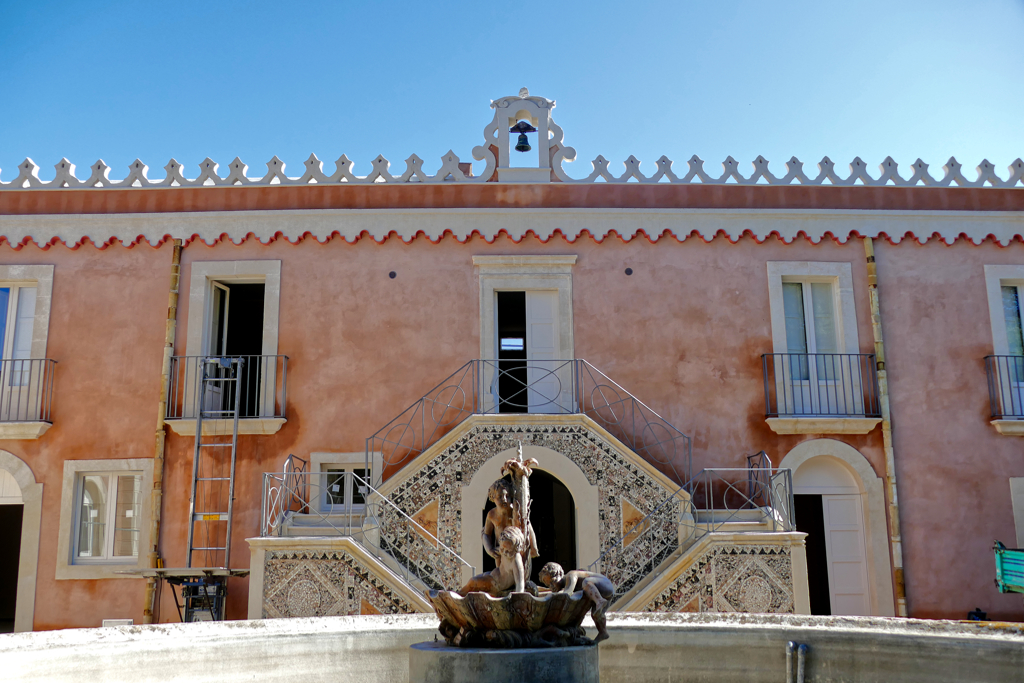
The park in which the museum is located not only houses archaeological remains, but also the gravesite of the German poet August von Platen, who died in Syracuse in the 19th century.
The museum is open from Tuesday to Sunday between 9 a.m. and 6 p.m. Sundays, they are closing already at 1 p.m. The entrance fee to the building is 10 €uros, however, entrance to the beautiful garden is completely free.
Catacombe di San Giovanni
Between the Parco Archeologico della Neapolis and the Archaeological Museum are the Catacombs of St. John the Evangelist.
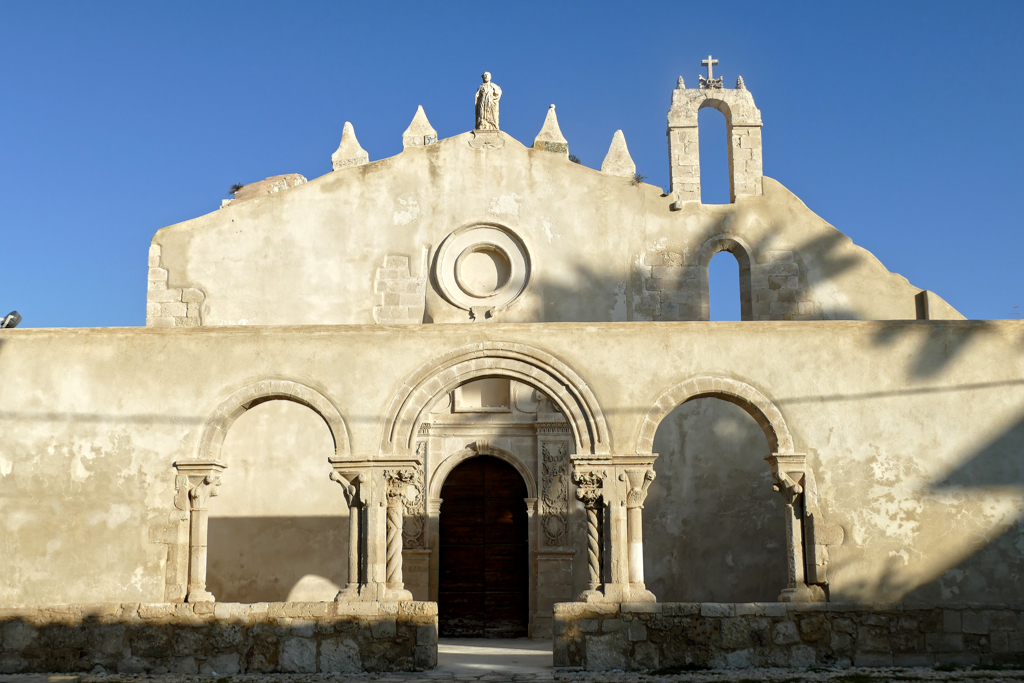
As a matter of fact, Syracuse’s catacombs are among the largest of their kind after those in Rome. They consist of the oldest ones, hence, the catacombs of Santa Lucia, followed by the catacombs of Vignia Cassia, and the catacombs of San Giovanni which are the newest ones. They emerged from the year 315 around the tomb of Marcian of Syracuse, the city’s legendary first bishop, who is said to have died a martyr’s death in the middle of the 1st century. In the 4th century, the first cathedral of Syracuse was built over the burial site. The graves were then used until the end of the 5th century.
Resting In Peace
The catacombs of San Giovanni contain around 10,000 both family and communal graves. In 1872, the magnificent sarcophagus of Adelphia was discovered. It is now on display at Syracuse’s archeological museum.
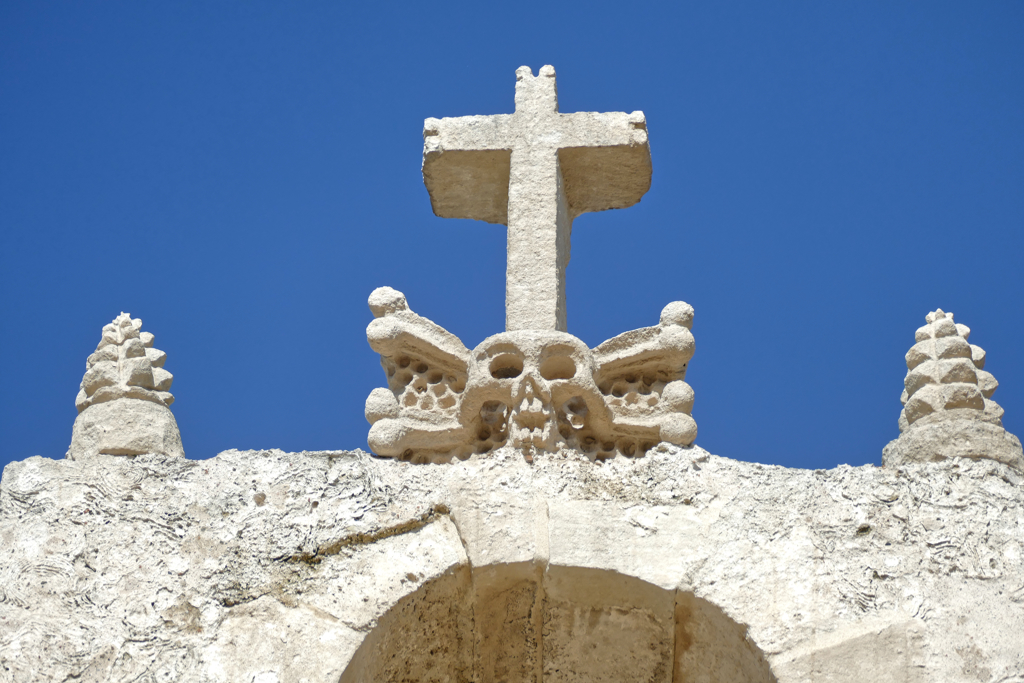
The church of San Giovanni alle Catacombe served as the cathedral in the diocese from the 3rd to the 7th century. The Arabs destroyed it as they conquered Syracuse. Eventually, the Normans built a new church, which fell victim to an earthquake in 1693.
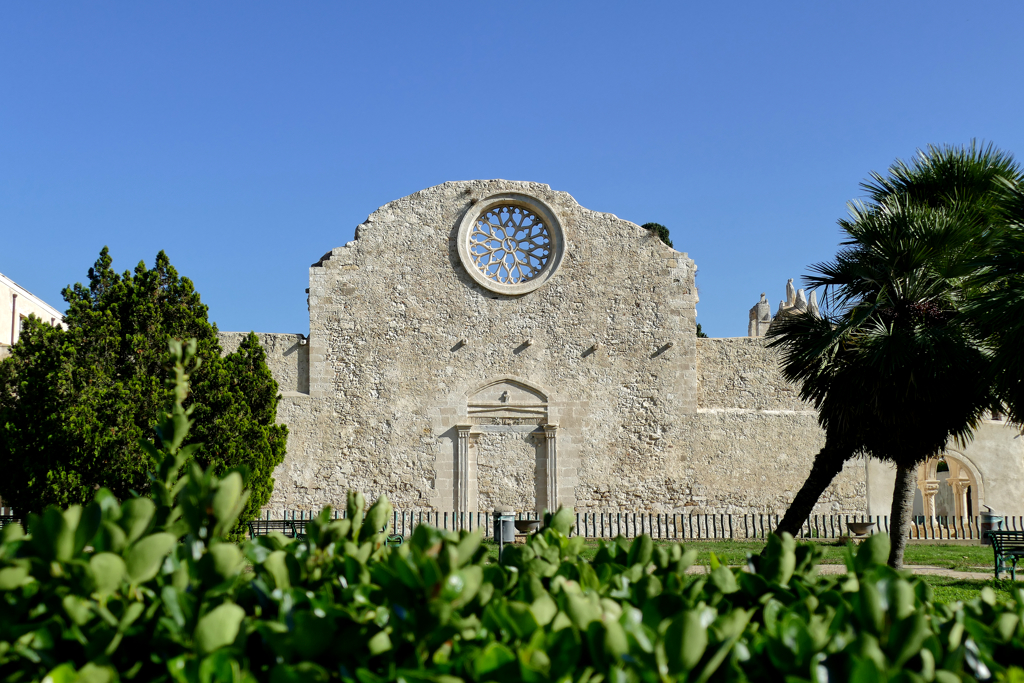
Below is the crypt of Saint Marcian. The crypt is the oldest church in Syracuse and one of the oldest in Christianity. Inside is a single column, considered the site of the martyrdom of Saint Marcian. Also, there are four columns whose capitals depict the four evangelists in the center of the crypt.
Depending on the season, the opening hours of the Catacombe di San Giovanni differ. You can check them on their website. The general entrance fee is 10 €uros.
Santa Lucia al Sepolcro
I had the great privilege of living in the Santa Lucia district. When I travel, I always like to be in the middle of real life, and the residential neighborhood of Santa Lucia is simply perfect for that. Small grocery stores, hairdressers, and lots of bars where I can indulge in my favorite pastime in Italy: I love sitting shoulder to shoulder with the locals while having my latte and a croissant filled with pistachio cream at the counter. I’ve already raved about this in many of my Italy posts. So now you’re in the middle of Santa Lucia, a district named after the city’s saint.
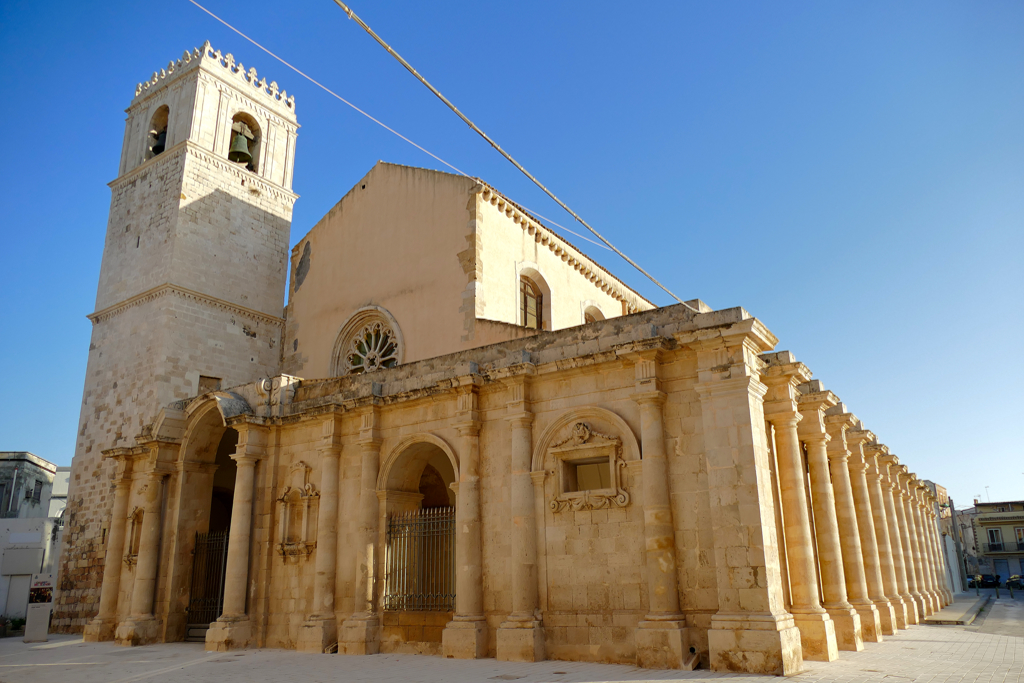
Lucia is said to have been beheaded in the 4th century where the church stands today. None other than Caravaggio captured her funeral in a painting that now hangs over the altar.
Going Down
The Catacombs of Santa Lucia are the largest complexes of their kind in Sicily. When they were no longer used for cemetery purposes, a place of worship was set up in them. The catacombs of Santa Lucia have not yet been completely uncovered, but the oratory and part of the catacombs can be visited as part of a guided tour.
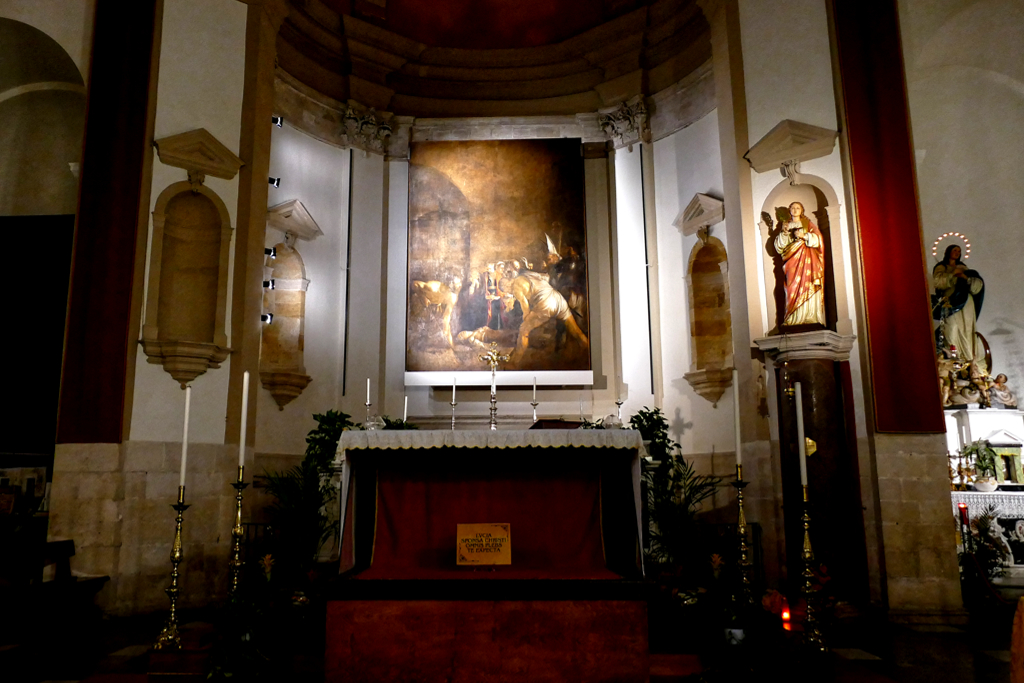
The Byzantine oratory was in use until the 13th century. There you can also admire the fresco of the so-called 40 Martyrs of Sebaste from the 8th century.
Depending on the season, the opening hours of the catacombs and the tomb vary. You can check them on their website. The general entrance fee is 10 €uros.
Since the church is a regular house of worship, a visit is possible every day from 9 a.m. to 12.45 p.m. and then again from 3.30 p.m. to 7 p.m. free of charge.
Caravaggio in my Hood – Street Art in Syracuse
I was very impressed to live in the neighborhood of a real Caravaggio. In his painting called Seppellimento di Santa Lucia, Caravaggio did not gloriously depict martyrdom, as is usually the case. The actual pictorial focus here is not the saint, but the two strong gravediggers. This was an unusually neo-realistic depiction for that era. Well, we know that not everyone appreciated Caravaggio for his unusual perspectives.
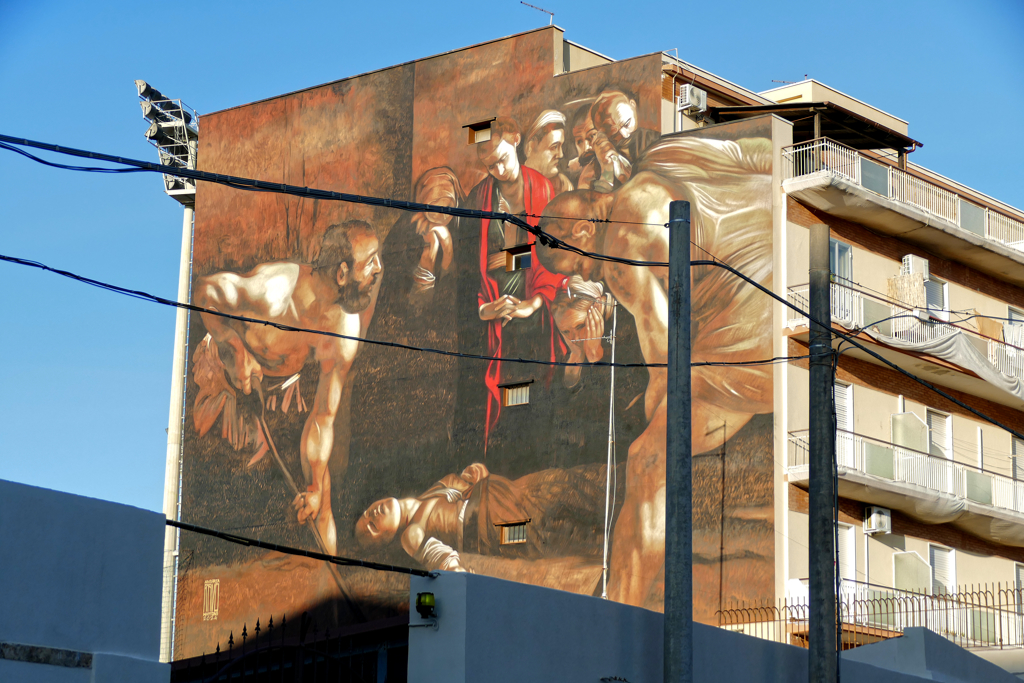
I was all the more pleased one morning on the way to school when I saw an artist on a lifting platform who had sketched the central motif of the painting with white chalk on a house wall and was already coloring in the first parts. Wow – a work of art in the making! I went to Taormina for the weekend the next morning and when I returned on Sunday evening, the work was finished. I assume that Caravaggio took longer than just a weekend to complete his picture.
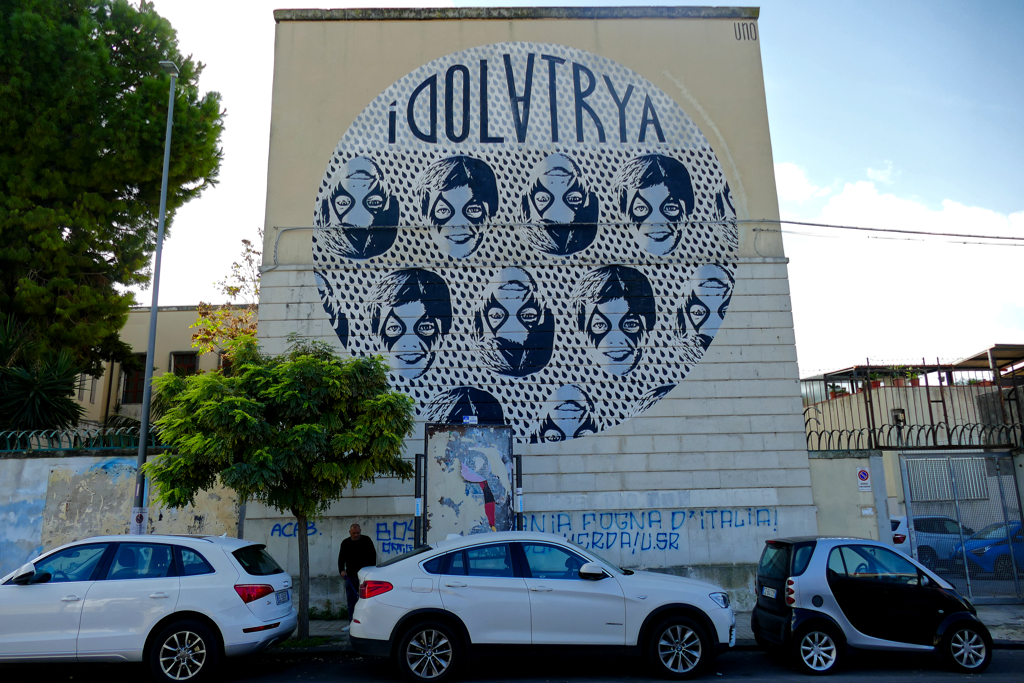
Only later did I find out that the well-known street artist Andrea Ravo Mattoni had interpreted the gem on the house wall next to the church. This is very fitting since he is known for paying tribute to his art-rich homeland by honoring famous masterpieces in his murals.
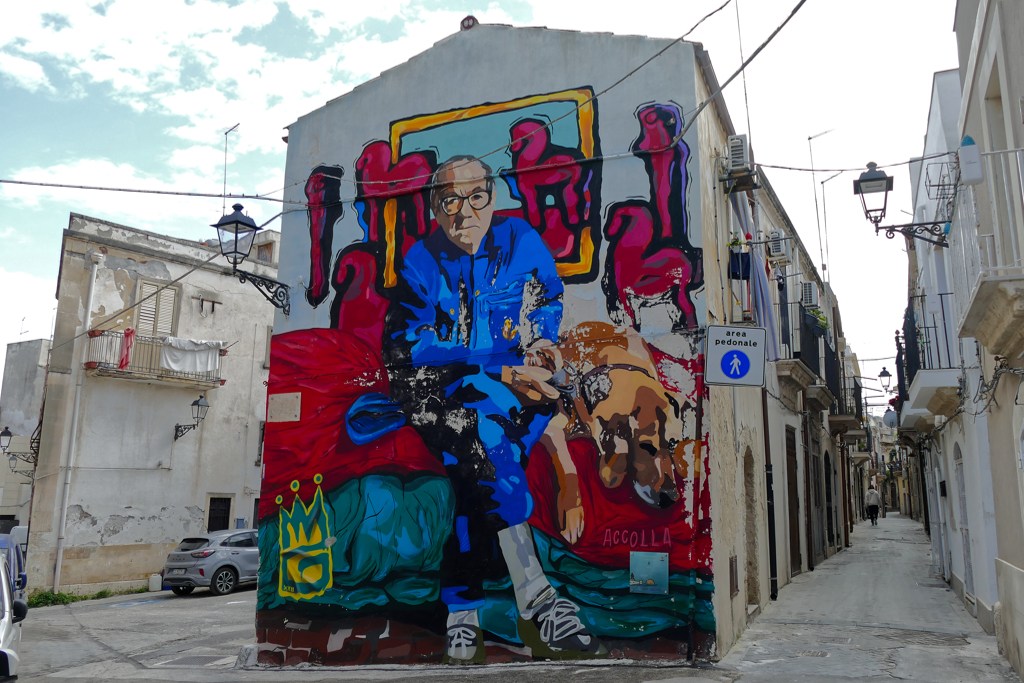
Apart from this amazing masterpiece, not many murals are found in Syracuse. Yet, I’m happy to introduce some works you’ll find on Viale Teocrito as well as in Ortigia.
Benvenuti ad Ortigia
Talking ’bout Ortigia: it is a small peninsula and yet the historical heart of Syracuse as it is renowned for its rich history, architectural beauty, and cultural significance.
Two bridges connect the islet with the modern part of Syracuse. The city’s undisputed most famous son welcomes visitors right here. Of course only as a bronze statue, as the most important mathematician of antiquity died in his birthplace in 212 BC.
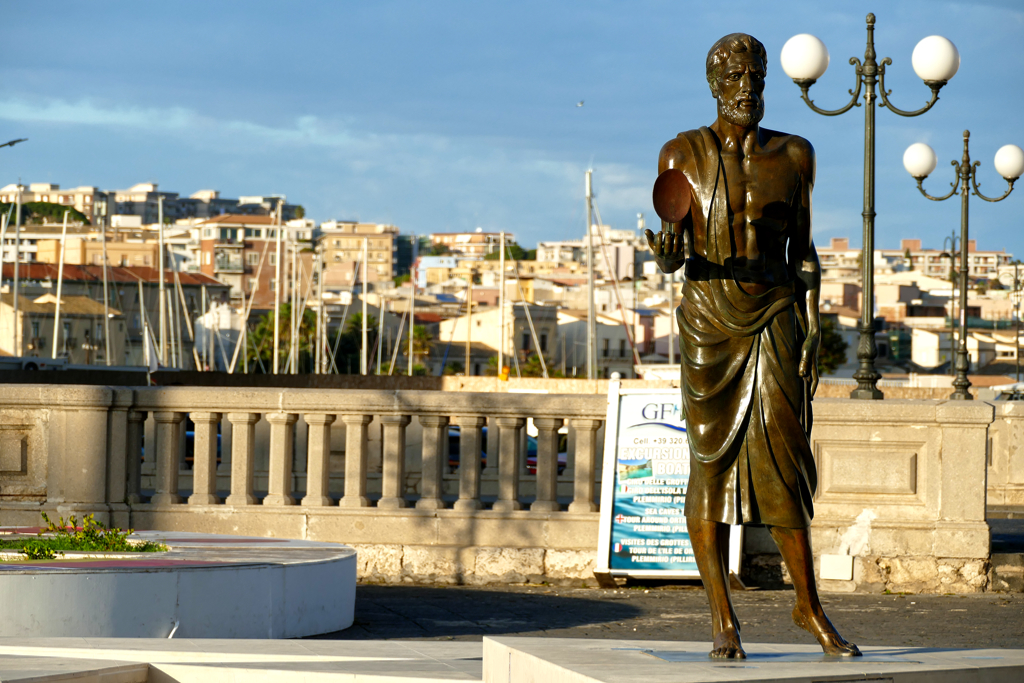
But why did the Greek Archimedes live and work in Sicily? Well, Ortigia was settled by the Greeks in the 8th century BC when Corinthians founded Syracuse. It became the nucleus of the city, playing a pivotal role in Greek colonization. It housed important sanctuaries, such as the Temple of Apollo, one of the oldest Doric temples in Sicily.
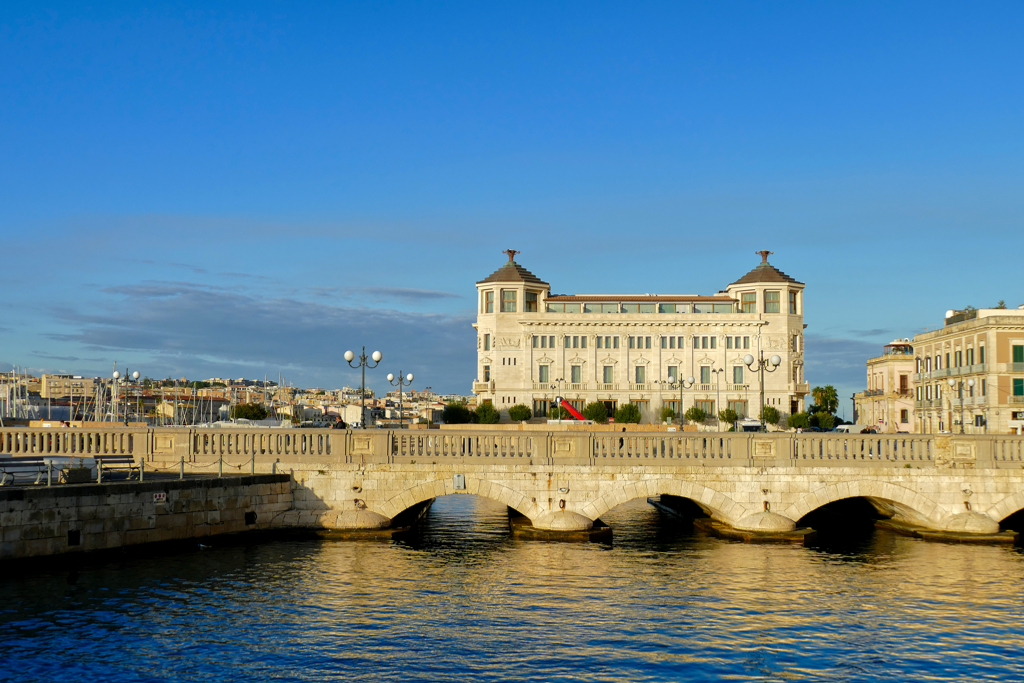
During its peak, Syracuse rivaled Athens and Carthage in wealth and power, partly due to Ortigia’s strategic position. The Temple of Athena, later converted into a cathedral, is a symbol of this era’s prosperity.
After the fall of the Roman Empire, Byzantine, Arab, and Norman influences shaped Ortigia’s faith and appearance.
After a devastating earthquake in 1693, the Baroque period brought significant architectural renewal. You’ll see it around the stunning Piazza del Duomo and its cathedral.
Grand Tour of the Peninsula of Ortigia
Today, Ortigia is a living testament to thousands of years of history, blending ancient grandeur with vibrant modern life alongside narrow, winding streets, and delightful piazzas. Surrounded by the turquoise waters of the Ionian Sea, it is accessible by charming bridges from the mainland. All this makes the peninsula one of Sicily’s most iconic destinations.
Mercato
Once you cross the Ponte Umbertino, I recommend you turn left and start your tour at the famous Mercato di Ortigia. Although I love shopping at farmer’s markets for tasty and healthy cooking, they are admittedly not one of my favorite places to go to when I travel. When I don’t shop, I avoid them.
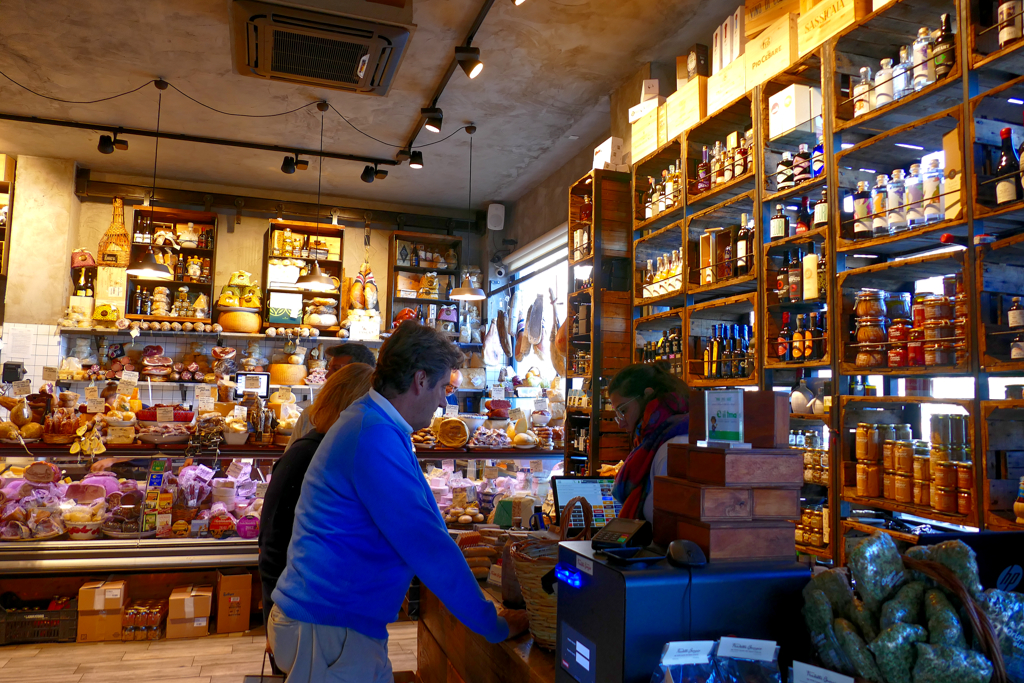
But since I know that a visit to the market, especially in the Mediterranean region, is one of the highlights for many travellers, I would like to emphasize that several blocks north of the bridge to the sea are full of market stalls on weekdays from 7.30 a.m. to 2 p.m. where you can buy fruit, vegetables, fish, herbs, and spices. Also, local souvenirs are on offer at a reasonable price.

Iconic snack bars like Caseificio Borderi are also great places to enjoy a delicious lunch. They are not tourist traps, but are frequented by visitors and locals alike.
Lungomare di Levante Elio Vittorini
Especially if you value optimal light when taking photos, you should walk Ortigia from the east-facing side until midday.
The Lungomare di Levante Elio Vittorini is a picturesque seafront promenade encircling the eastern edge of the peninsula. Named after the renowned Italian writer Elio Vittorini, this walkway offers visitors a harmonious blend of natural beauty, historical landmarks, and authentic Sicilian culture.
Strolling down the coast, you can enjoy breathtaking views of the Ionian Sea. The gentle sea breeze and the rhythmic sound of waves create a serene atmosphere, making it an ideal spot for leisurely walks, photography, or simply unwinding while gazing at the horizon for instance from the elevated Forte San Giovannello.
The area surrounding the Lungomare di Levante is dotted with charming cafes, seafood restaurants, and boutique hotels. Establishments like Hotel Gutkowski*, situated on the promenade, provide visitors with an authentic Sicilian experience, combining modern comforts with traditional charm.
In addition, the promenade is adjacent to several bathing bays and notable landmarks.
Papyrus Museum Corrado Basile
One attraction not to miss is the Papyrus Museum Corrado Basile. It is a unique institution dedicated to the study and preservation of papyrus, a material integral to ancient cultures and the history of Syracuse itself as the city boasts the largest colony of papyrus plants in Europe.
The museum showcases a comprehensive collection of artifacts, including ancient papyrus documents, papyrus-made items like sandals and boats, and detailed explanations of the papyrus-making process.
Beyond its exhibits, the museum is actively engaged in teaching and research, focusing on the origin and preservation of papyrus scrolls. This commitment underscores its role in safeguarding an essential part of human history.
As the opening hours differ according to tourist season, you should check out their website when planning your visit. The general entrance fee is 5 €uros.
Museo dei Pupi
Another unique museum to visit in Ortigia is the Museo dei Pupi. It offers a captivating journey into the traditional Sicilian art of puppetry, known as Opera dei Pupi. This museum showcases a diverse collection of handcrafted puppets, each reflecting Sicily’s rich cultural heritage and storytelling traditions. Visitors can explore various exhibits that delve into the history and craftsmanship behind these intricate figures, providing a unique insight into this UNESCO-recognized art form.
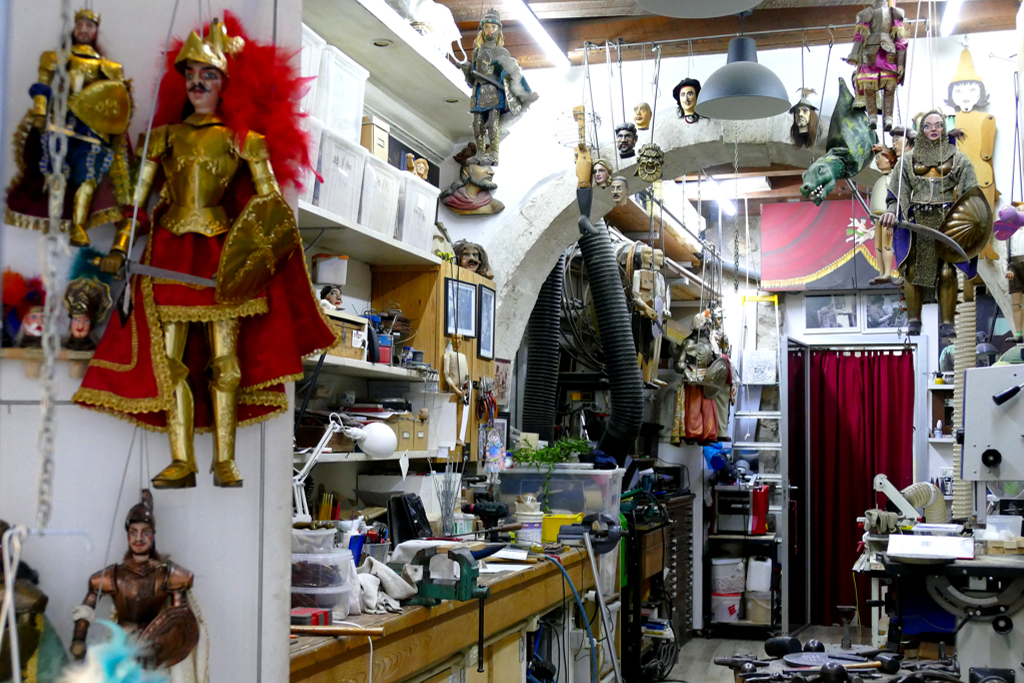
Just like when planning a visit to one of the other museums in Syracuse, it’s advisable to confirm the current opening hours before your visit on their website. The admission fee is 3 €uros.
Adjacent to the museum is the Teatro dei Pupi, where traditional puppet performances bring to life epic tales from medieval literature. These shows are renowned for their dramatic storytelling, vibrant characters, and the puppeteers’ skillful artistry. Performances are typically conducted in Italian, but the expressive nature of the puppetry ensures an engaging experience for all audiences.
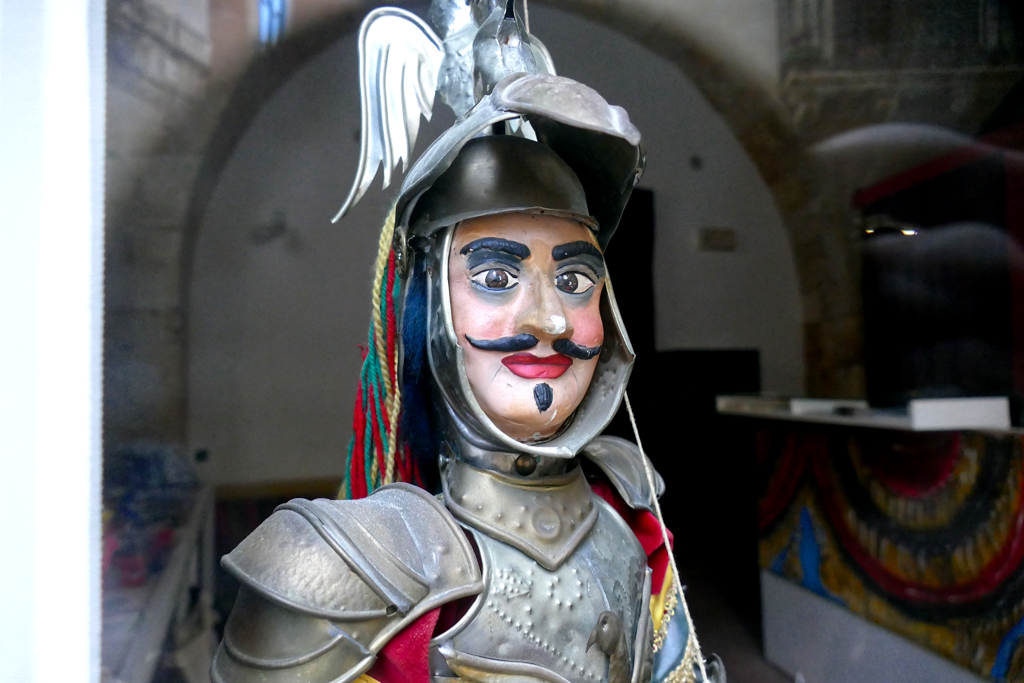
Performances usually last about one hour. It’s recommended to check the current schedule in advance on their website, as showtimes can vary.
Ticket Prices are usually 10 €uros per person. Due to the popularity of the shows and limited seating, it’s advisable to book tickets in advance.
Castello Maniace
The historic fortress Castello Maniace is located on Ortigia’s southernmost tip. It is a truly remarkable example of medieval military architecture but most importantly, it impresses with architectural beauty and stunning panoramic views of the Mediterranean Sea.
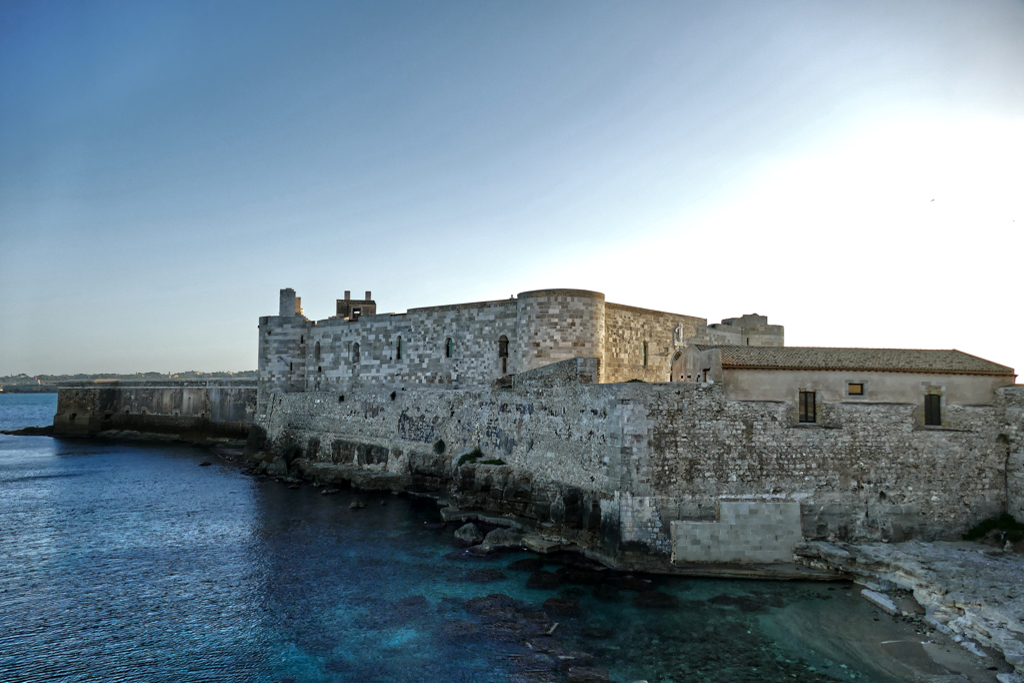
The castle was built between 1232 and 1240 by the Holy Roman Emperor Frederick II, who was also King of Sicily. Its purpose was to strengthen the defenses of Syracuse which, due to its location and history, was of strategic importance. Therefore, the layout is square-shaped with sturdy walls, a moat, and a massive cylindrical tower at each corner. It features a decorated entrance with a pointed arch, an example of Gothic influence. A drawbridge once connected the entrance to the mainland.
It was named after George Maniakes, a Byzantine general who recaptured Syracuse from the Arabs in the 11th century.
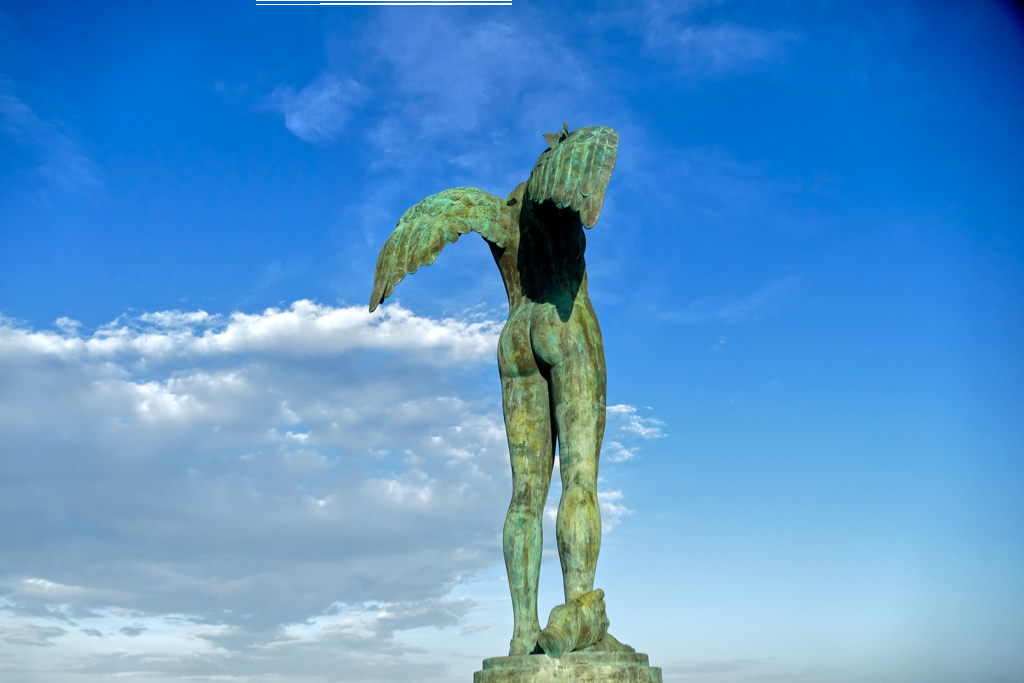
Mitoraj was a Polish sculptor who lived and worked mainly in France and Italy. The main theme of his work was the human body. Mitoraj was based on classical works by Michelangelo and Antonio Canova and liked to draw on mythological figures such as Ikaros, Centauro, Eros, and Mars. In Sicily, his works can be found at various archaeological sites, where they enter into an exciting dialogue with the finds.
I’m introducing another one of his amazing sculptures in my post on the Valle dei Templi of Agrigento.
Over the centuries, the castle served various roles, including a royal residence, military barracks, and prison. Today, however, it is a venue for cultural events and can be visited on guided tours. Opening hours and ticket prices vary seasonally, so checking ahead is advisable.
Fonte Aretusa
The Fonte Aretusa is a historic freshwater spring steeped in myth and natural beauty. It’s one of the island’s most iconic landmarks, offering a unique blend of history, mythology, and scenic charm.
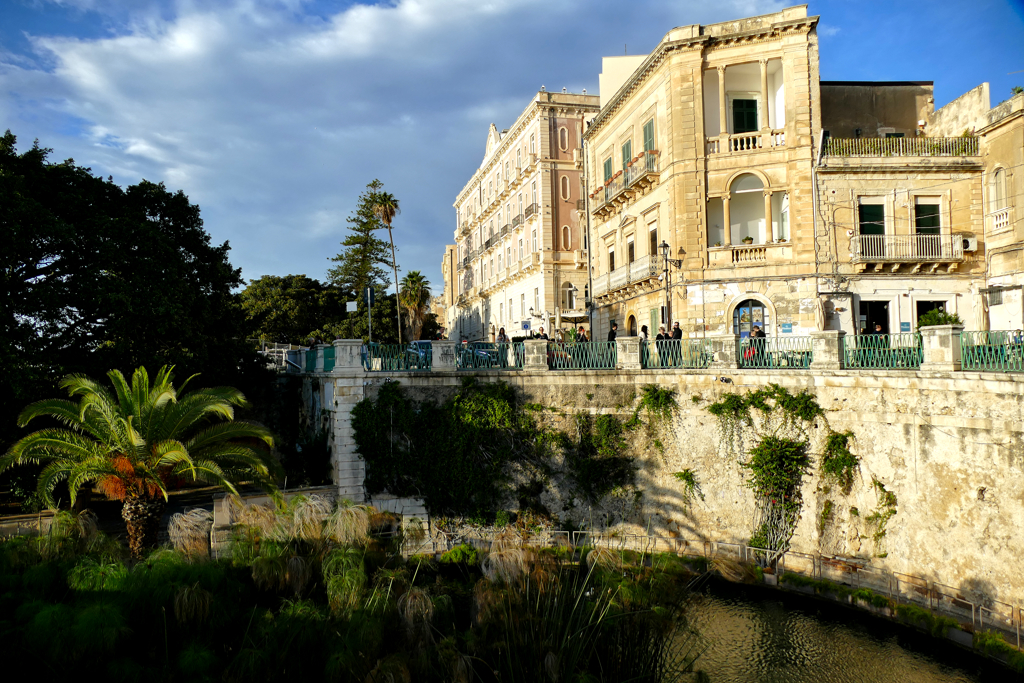
Actually, it is a natural freshwater spring that flows into a circular pool that is surrounded by lush vegetation. The most outstanding of this flora are papyrus plants, a rare sight in Europe. As the pool is located just a few meters from the sea, it forms a unique juxtaposition of freshwater and saltwater environments. In ancient times, however, the spring was a vital water source for the city of Syracuse.
The Legend
According to legend, the nymph Arethusa fled from the river god Alpheus, who was in love with her. She sought the help of the goddess Artemis, who transformed her into a spring to escape him. Alpheus, however, turned into a river and united with Arethusa, symbolizing eternal love.
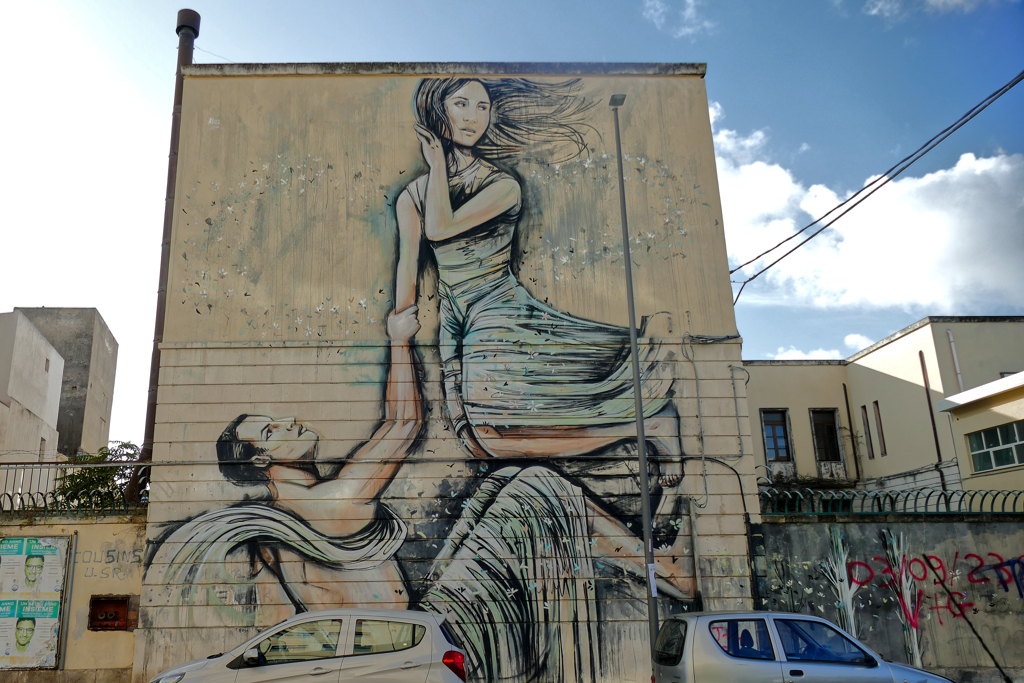
I’ve introduced the artist and her work also in my post Best Street Art in BERLIN.
All this makes the Fonte Aretusa far more than just a spring. It’s a vital connection to Ortigia’s rich past and mythological heritage, offering a serene and picturesque spot overlooking the Mediterranean. From here, you can continue your sightseeing either down Passeggio Aretusa alongside the waterfront where you’ll also find some of the best spots to swim or hang out on a beach chair.
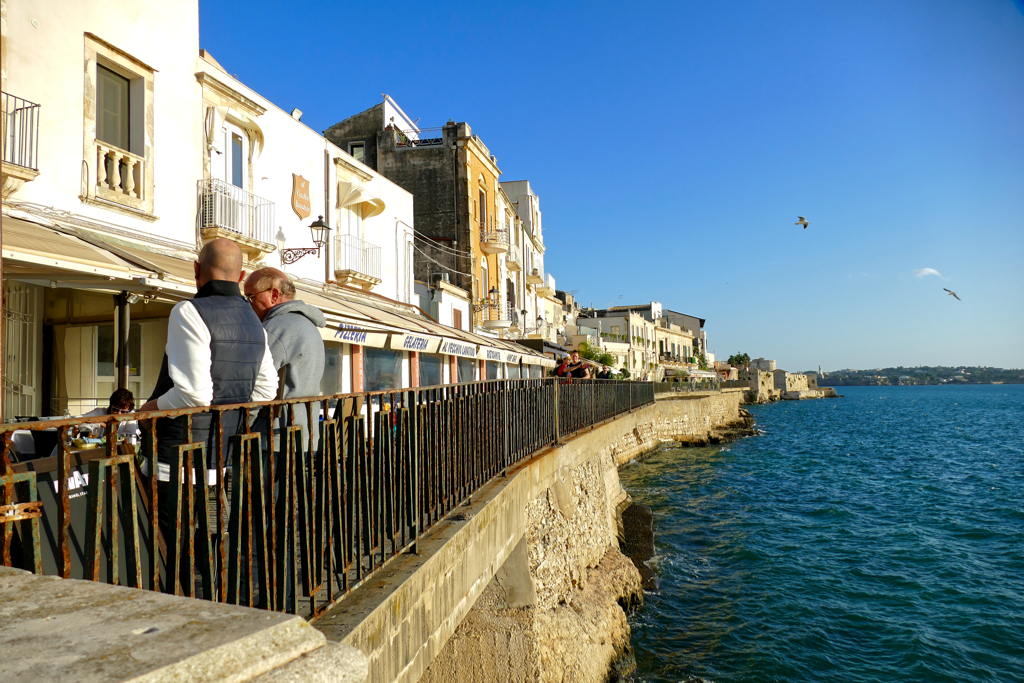
Or you walk up the Via Pompeo Picherali to get to Ortigia’s most important square, the Piazza Duomo.
My Tip
Even if there were no other reason to visit the Fonte Aretusa, the evening spectacle of the birds would be reason enough.
Every evening short before the sun sets over Ortigia, countless birds gather together and fly in artistic formations over the Aretusa spring and its surroundings. Even the world’s best choreographer couldn’t beat the aesthetics of this performance.
Chiesa di Santa Lucia alla Badia
If you come from the Fonte Aretusa, you enter the cathedral square from the south. The church of Santa Lucia alla Badia is located here. It is consecrated to the city’s patroness, obviously.
The original Cistercian monastery and church from the 15th century was completely destroyed by an earthquake in 1693. The important city architect Luciano Caracciolo took over the planning of the new church building in the Baroque style, which was completed in 1705.
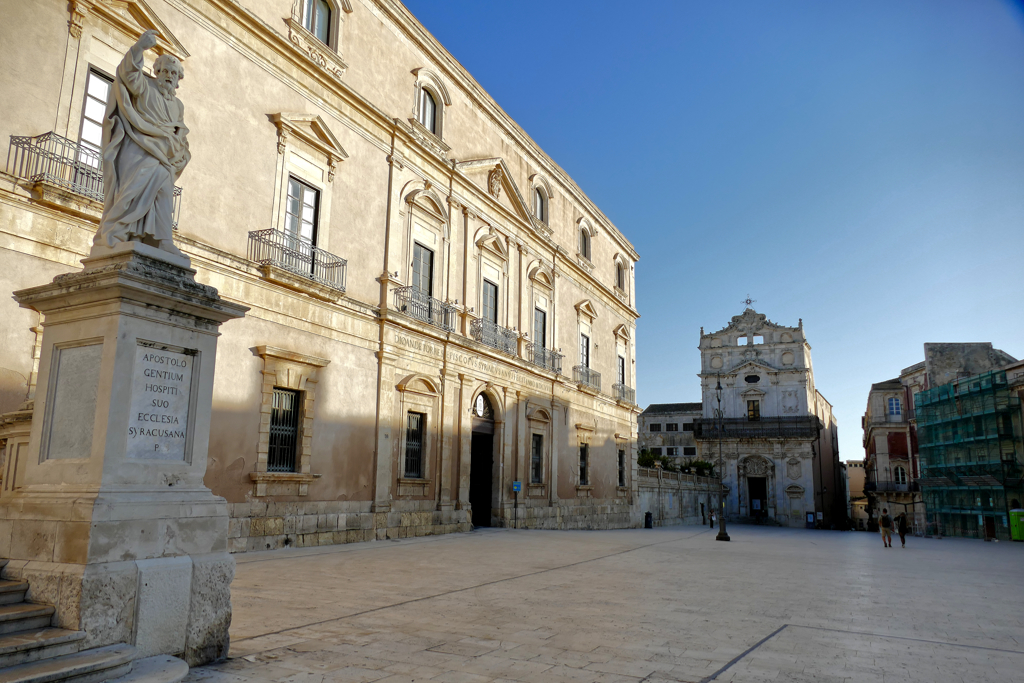
A delicately designed, wrought iron balcony divides the high front into two floors. The conclusion is a two-story façade with an iron cross. The Baroque entrance portal with its free-standing, winding columns and the rich decoration of the gable is reminiscent of the Plateresque style of Spain at the end of the 15th century.
The single-nave interior has four baroque altars. A dome with frescoes depicting the Triumph of Saint Lucia spans the presbytery.
The church can be visited from Tuesday to Sunday between 11 a.m. and 4 p.m. free of charge.
Cattedrale Metropolitana della Natività di Maria Santissima
While the Chiesa di Santa Lucia alla Badia certainly is a beautiful structure, the most imposing feature of the Piazza del Duomo is undoubtedly the Cattedrale Metropolitana della Natività di Maria Santissima. Oh, you’re in for a treat as this house of worship is nothing short of breathtaking! It is a living, breathing tapestry of history, art, and devotion all rolled into one.
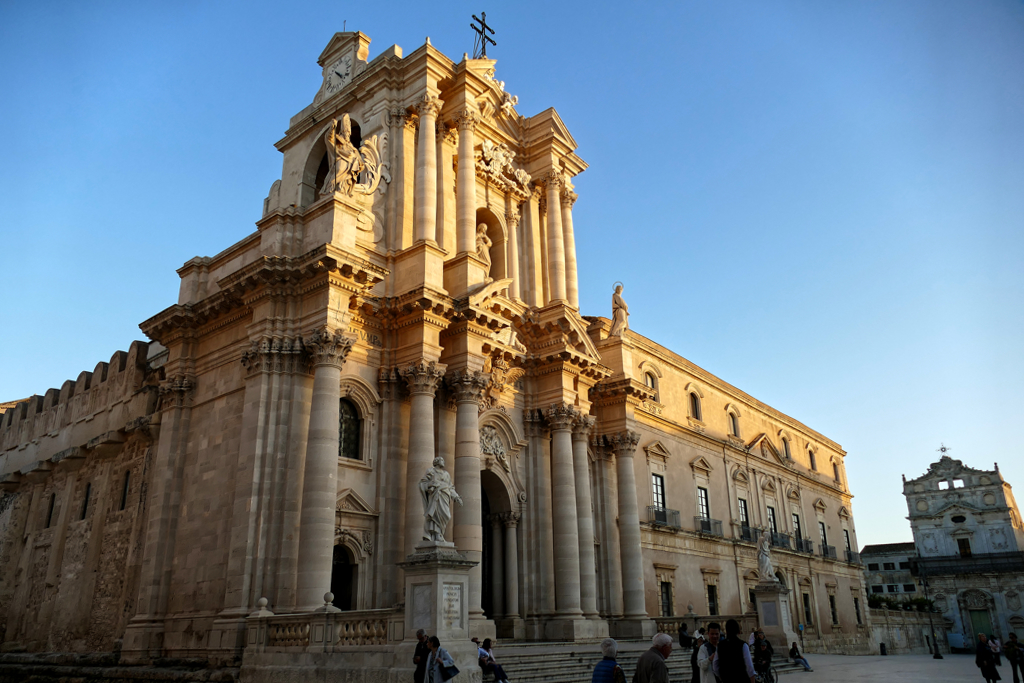
What makes it so extraordinary? For starters, it’s built atop the ruins of an ancient Greek temple dedicated to Athena. In fact, you can still see the original Doric columns embedded in the cathedral walls, seamlessly blending ancient Greek grandeur with the splendor of Sicilian Baroque.
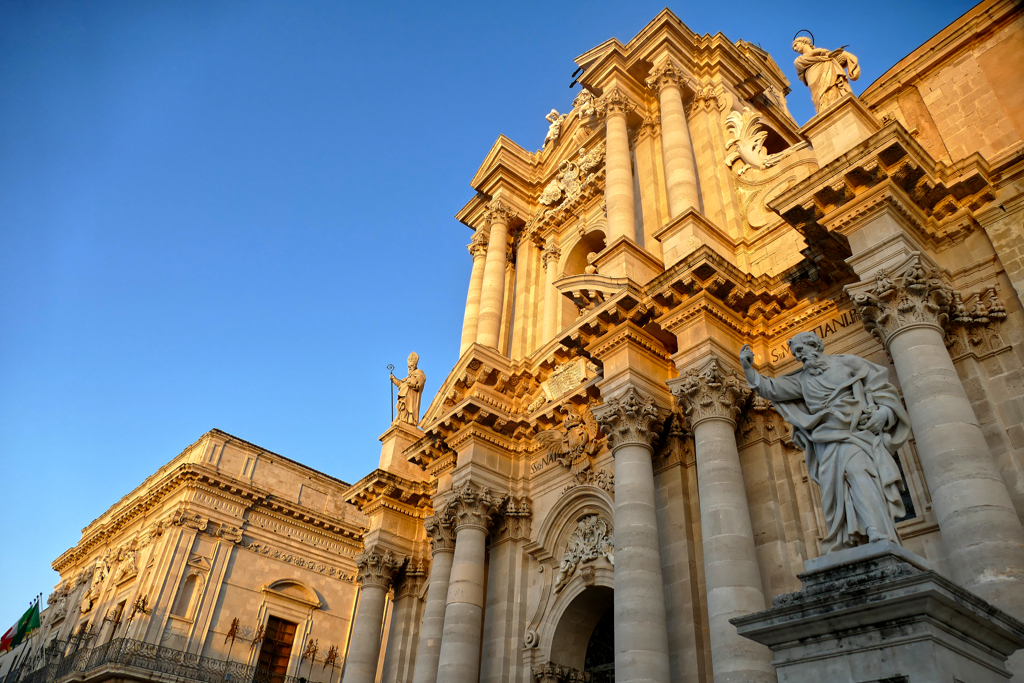
Then the façade is a masterpiece of Rococo extravagance, designed by Andrea Palma in the 18th century. It’s a glorious work of intricate carvings, statues, and curves that catch the sunlight in the most magical way. The interior is equally awe-inspiring, with its ornate chapels, shimmering altars, and stunning artworks, each one a testament to centuries of faith and artistry.
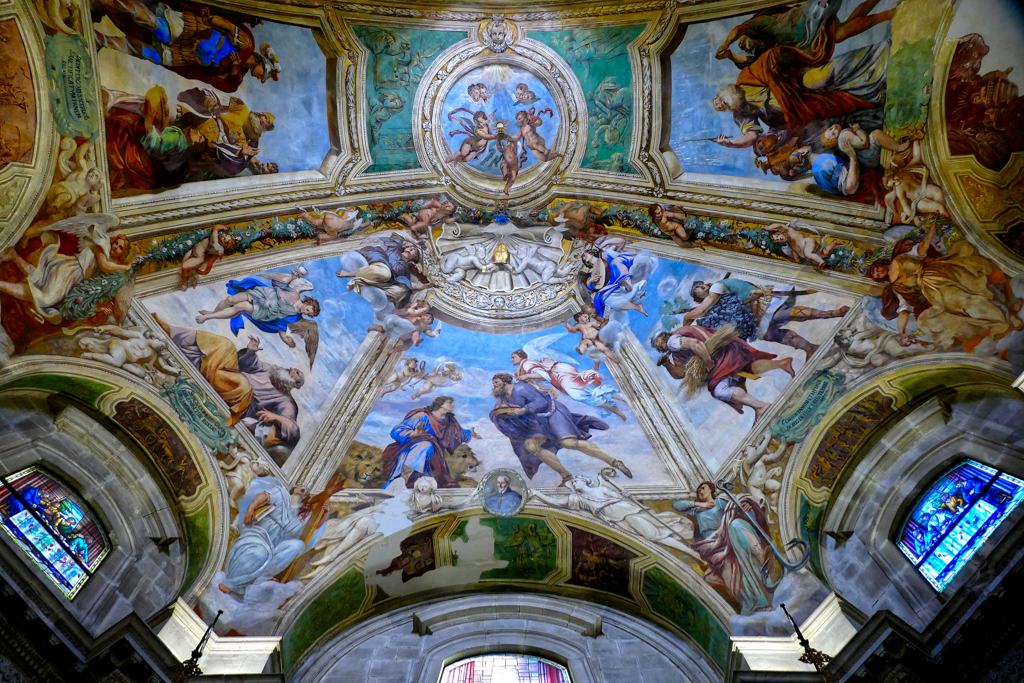
Visiting the cathedral feels like entering a sacred jewel at the crossroads of Greek, Roman, Arab, Norman, and Spanish cultures, each leaving its indelible mark.
My Tip
Obviously, Ortigia is beautiful at any time. However, I would advise you to time your visit to the Piazza Duomo in the afternoon, especially if you want to take beautiful photos.
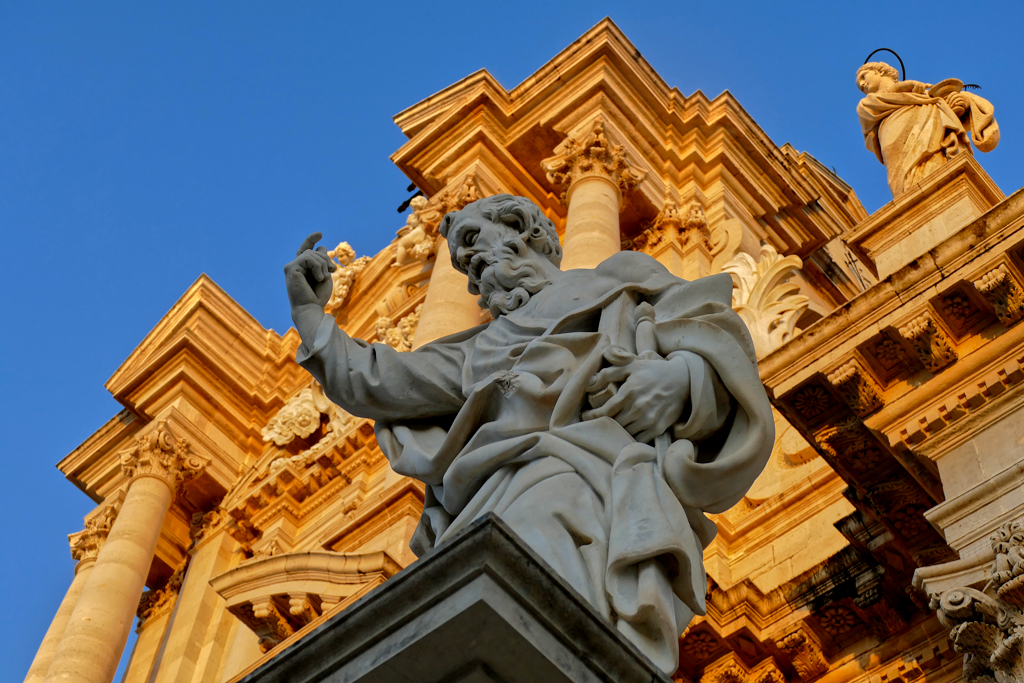
When you see the pale sunlight turning the sandstone facades into glowing gold in the early evening, you’ll understand why photographers call the period just before sunset the golden hour.
Palazzo del Vermexio
Right next to the Cathedral stands the Palazzo del Vermexio, a historic building and another one of the architectural highlights of the area.
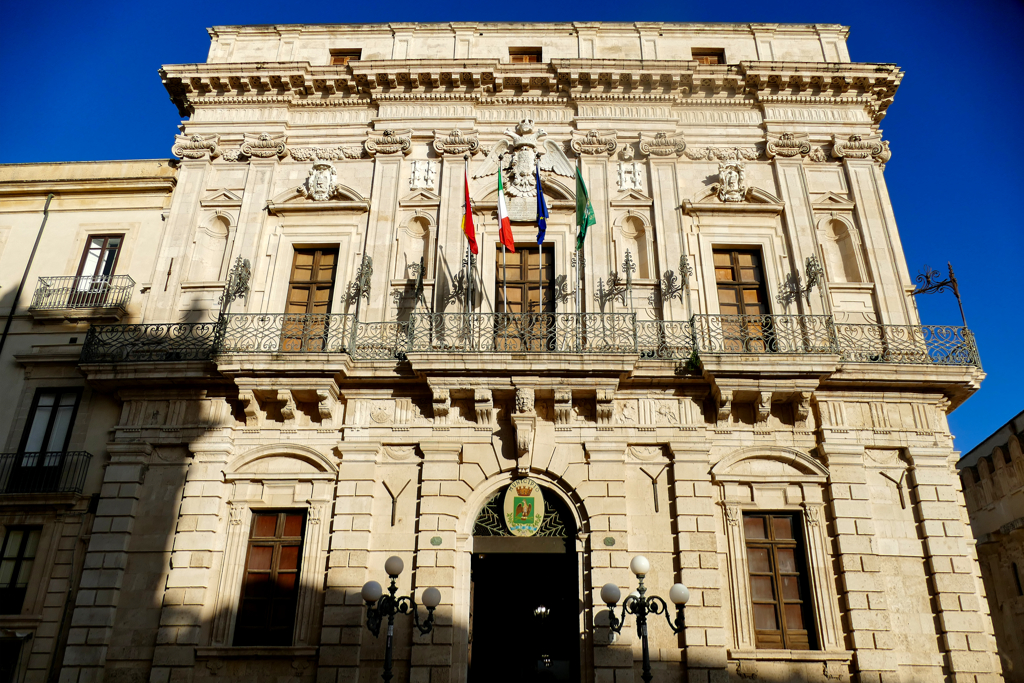
It was designed by the Spanish architect Giovanni Vermexio in the early 17th century and showcases a blend of clean lines and an elegant symmetry, typical of the Renaissance, combined with ornate Baroque decorations. One of the most famous details of the Palazzo is the small stone lizard carved into its façade, a playful signature left by Giovanni Vermexio.
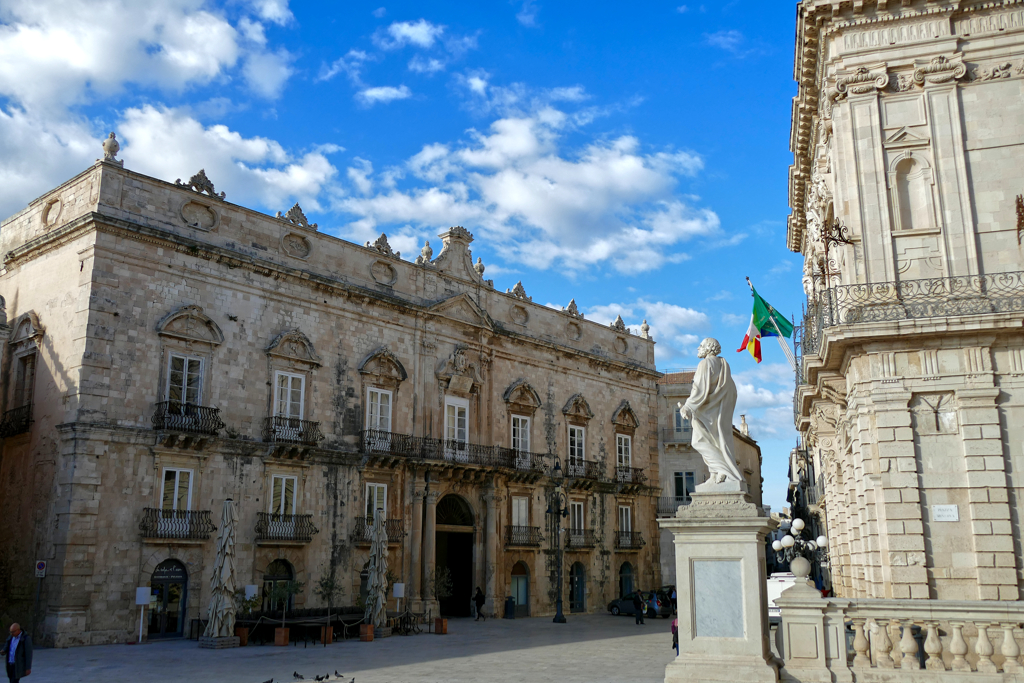
The building has long been the seat of Syracuse’s municipal government and remains a hub of administrative activity. Yet, the Palazzo del Vermexio is not just a municipal building. It embodies the historical layers of Syracuse, from its ancient Greek foundations to its Baroque splendor. Visitors to Piazza Duomo marvel at the harmonious architecture of the square, with Palazzo Vermexio being a central element of the ensemble.
Fontana di Diana And Around Piazza Archimede
The Fontana di Diana is a striking public fountain located in Ortigia’s central square of Piazza Archimede. Designed by Giulio Moschetti in 1906, the fountain is a blend of Neoclassical and Art Nouveau styles. It is an iconic feature of the city and celebrates the mythology and history of the region.
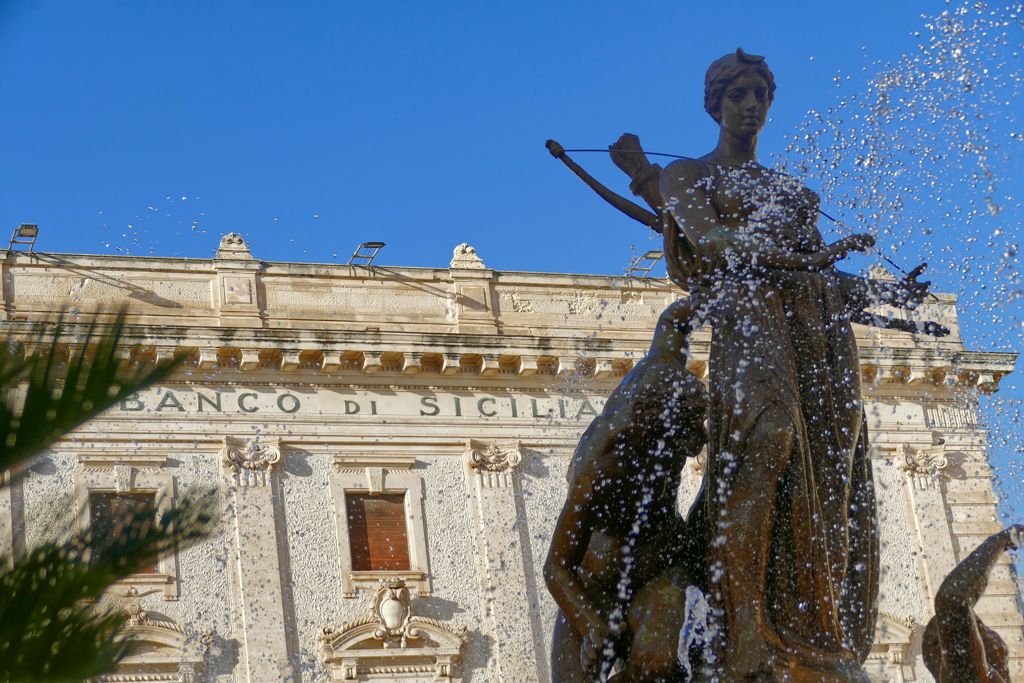
Obviously, it is dedicated to Diana, the Roman goddess of the hunt, who was known as Artemis in Greek mythology. The goddess was considered the protector of Ortigia, and her mythology is intertwined with the city’s origins.
Around the central statue, some figures tell the myth of Arethusa, a nymph who fled from the river god Alpheus and was supposedly transformed into a freshwater spring.
In the Side Alleys
Just a few steps from Piazza Archimede is Pasticceria Artale. Quite rightly, it is a highly popular pastry shop. For over 40 years it has been offering a wide range of traditional Sicilian sweets, including cannoli with ricotta, chocolate or cream, Cassatine Siciliane, and various Bignè variations. Their granita variations, such as almond and pistachio granita, are particularly popular and are highly valued by visitors and locals alike
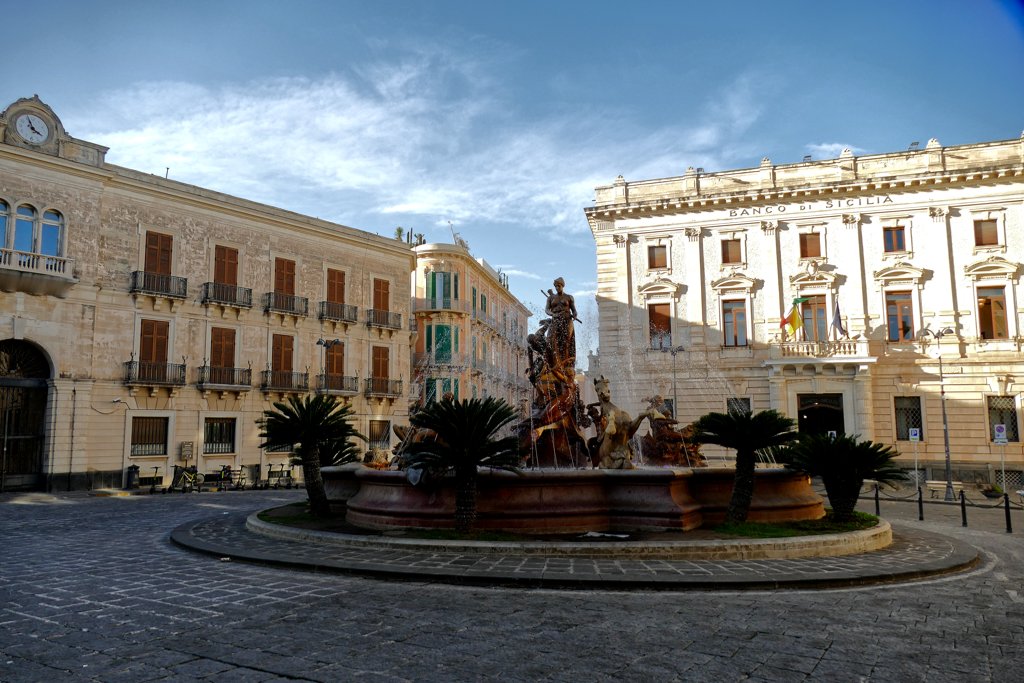
If you’re more hungry for education than sweets, I highly recommend visiting the Museo Leonardo Da Vinci e Archimede. It offers a captivating journey into the minds of two of history’s greatest inventors, Leonardo da Vinci and Archimedes, obviously.
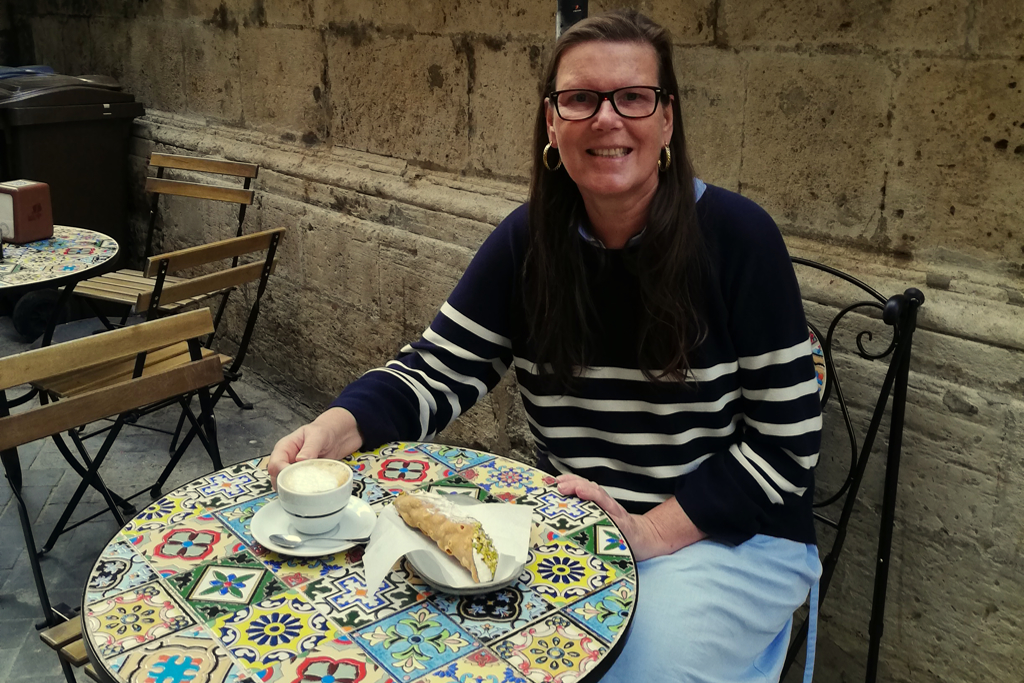
The museum features detailed reproductions of Leonardo and Archimedes’ inventions, many of which are interactive, allowing visitors to engage directly with the mechanisms and understand the principles behind them.
With over 45 models covering subjects like mathematics, engineering, physics, and human anatomy, the museum provides insights into the innovative minds of these geniuses, making it both informative and inspiring for visitors of all ages.
The museum is open daily from 10.30 a.m. to 7 p.m. and a general ticket costs 6.50 €uros.
Tempio di Apollo
As the Temple of Apollo is located just off the bridges connecting the peninsula with the newer part of town, for some it is the first and for others the last landmark to admire in Ortigia. Either way, it is one of the oldest Doric temples in the Greek world and holds significant historical and architectural importance. Dating back to the early 6th century BC, it showcases the early stages of Greek architecture in Sicily.
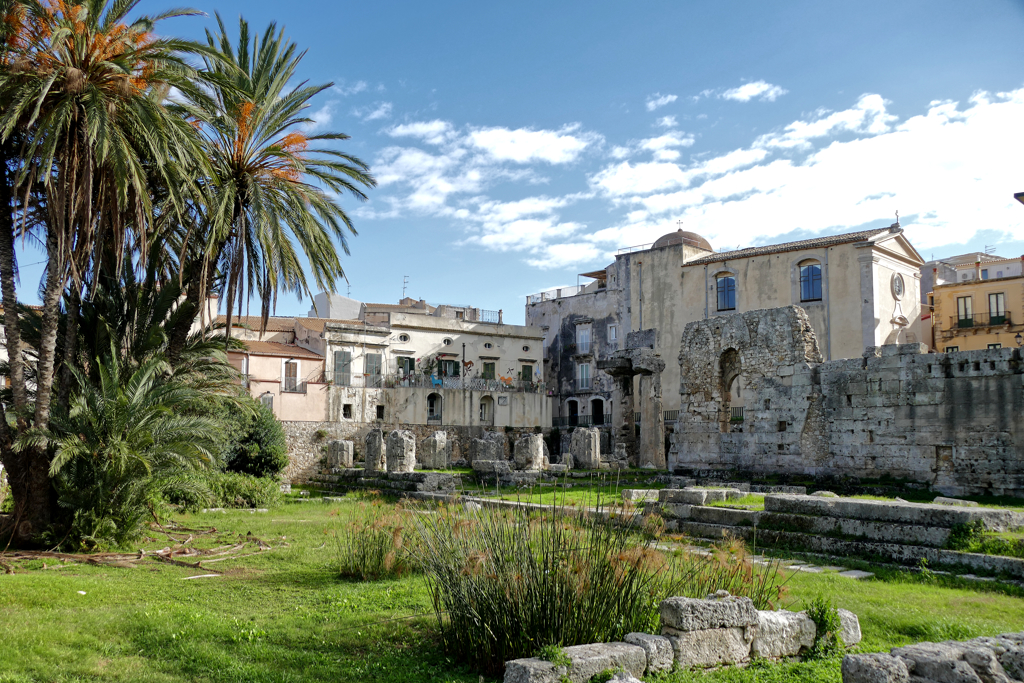
The temple reflects the Hellenic colonization of Sicily and serves as a testament to the cultural and artistic influence of the Greeks in the Mediterranean. It was dedicated to the Greek god Apollo, one of the most revered deities in Greek mythology, associated with music, prophecy, and healing.
Being a Doric peripteral structure, the building was surrounded by a single row of columns. Originally, the structure had six columns on the shorter sides and 17 on the longer ones.
Its massive size and proportions indicate that the Temple of Apollo was a significant sanctuary in that era.
Over the centuries, the building underwent various transformations and served as a Byzantine church, an Islamic mosque, and later a Norman church during medieval times. Today, however, the remains include just a few standing columns, parts of the base, and some of the walls.
Day Trips into Sicily’s Baroque Past
If you are in Syracuse for a few days, you should definitely consider visiting the baroque cities of Noto, Modica, and Ragusa. UNESCO has declared these three towns as World Heritage Sites because of their magnificent baroque churches and palaces.
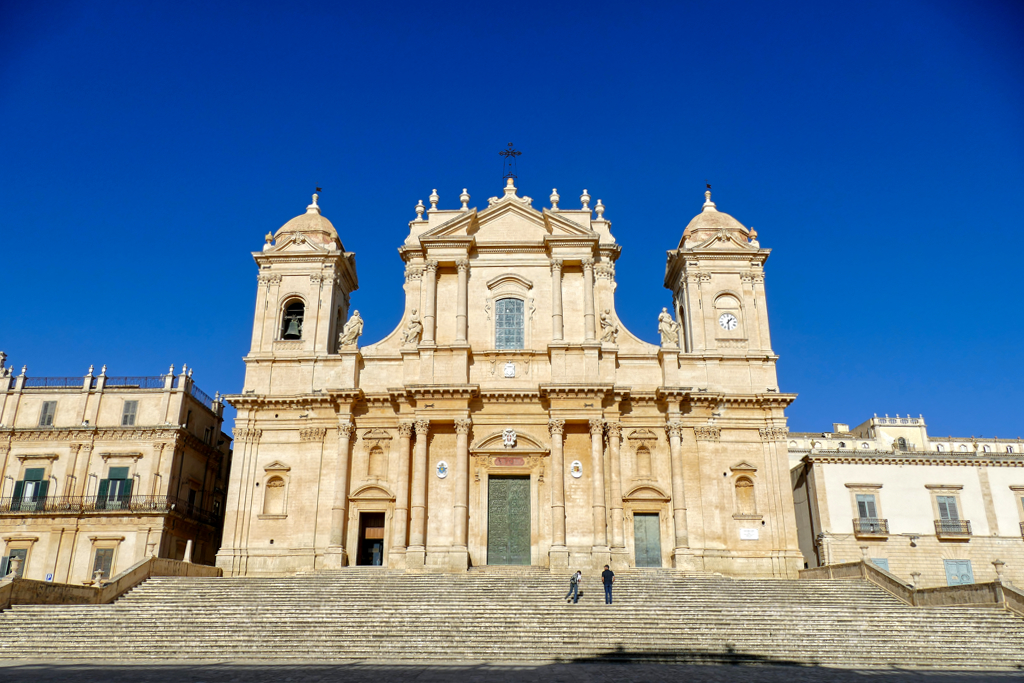
A day trip from Syracuse is also easily possible using public transport, although you will have to plan the trip to Ragusa a little better if you don’t want to spend the night there.
However, the old town of Ragusa Ibla fascinates with narrow streets, palaces, and the magnificent Cathedral of San Giorgio. The city also offers breathtaking views and an authentic Sicilian feel and is definitely worth the extra time it takes to get there!
Famous for its baroque splendor as well as chocolate production, Modica combines history with enjoyment. Particularly worth seeing are the churches of San Giorgio and San Pietro, which sit majestically on the hills. Note that most buses to Modica, just like to Ragusa, leave from Catania which is a huge detour from Syracuse. Therefore, in this case, taking the train is a better option.
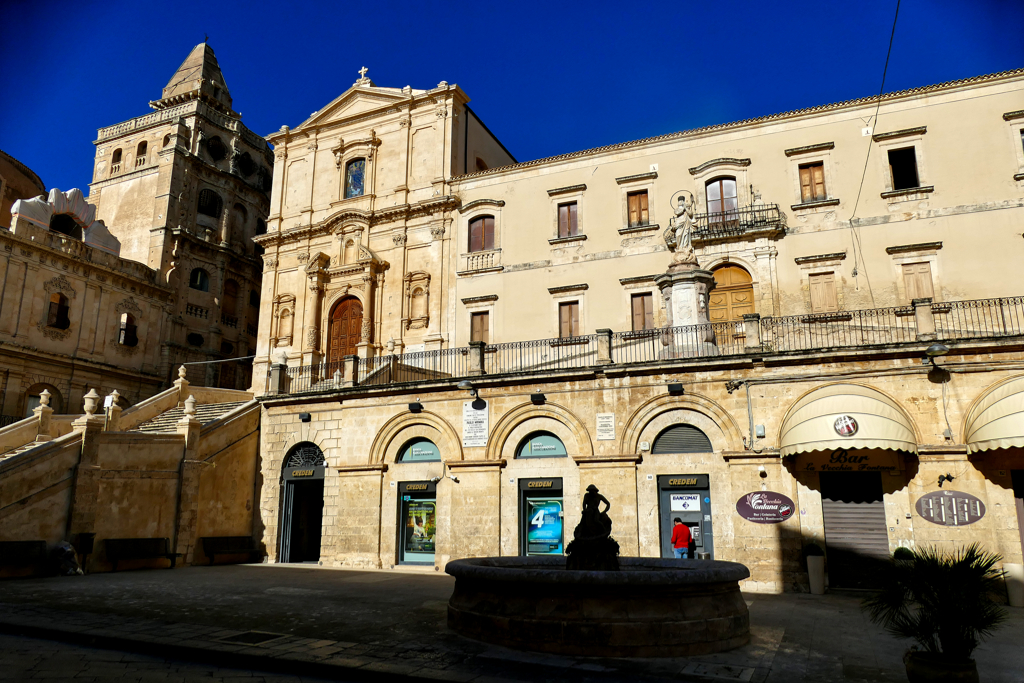
Noto, the so-called capital of the Sicilian Baroque, can be reached by bus almost every hour; the last direct bus back to Syracuse leaves at 3.55 p.m.
In Noto, you will find magnificent palaces and churches, especially the Cathedral of San Nicolò, rebuilt in Baroque style after the earthquake of 1693. Take a look at what Noto has to offer in my guide What to See in NOTO, the Baroque Town of Sicily.
Practical Information
How to Get There
By Plane
The nearest airport is Vincenzo Bellini Airport in Fontanarossa on the outskirts of Catania. It is the busiest airport in Sicily with a wide choice of domestic and international flights.
There are various bus connections to Catania’s city center as well as direct connections to other Sicilian cities such as Syracuse and Taormina.
By Ferry
Travelling to Sicily by ferry is a popular and scenic option, offering connections from mainland Italy and other locations. The most common national routes are from Villa San Giovanni in Calabria to Messina. This is the shortest crossing as it connects the tip of the mainland to northeastern Sicily so the ride takes only around half an hour. Also, ferries run frequently, often every 30 minutes. From Pozzallo in Malta, you’ll get to Catania in two to three hours, depending on the route and the vessel. Also, there are frequent high-speed ferries from Valletta to southeastern Sicily. However, in the main post The Best Places to Visit in SICILY in One Week you will find information about many other connections.
Land Transport
Getting to Sicily by train or overland bus from mainland Italy is straightforward, thanks to well-established transportation networks. Also, it is a very relaxed and scenic option.
Direct trains connect major Italian cities to Sicilian destinations such as Palermo, Catania, Messina, and Syracuse. As you opt for an overnight service, you save time and even money for accommodation. Trains to Sicily board a ferry to cross the Strait of Messina which usually takes around half an hour. Passengers remain on the train as it is loaded onto the ferry.
To give you an idea: From Milan, the overnight train takes 20 hours, from Rome it takes twelve hours, and from Naples, it takes only seven. Tickets can be purchased through Trenitalia and advanced booking is recommended, especially during the high season and for overnight journeys.
Obviously, long-distance buses connect cities on the Italian mainland with major cities in Sicily, too. They take a bit longer but are also cheaper. The most popular operators are Flixbus and Itabus.
In Sicily, trains are also connecting bigger cities, however, travelling by overland bus is far more popular as it is a more reliable and even a bit cheaper option. Also, in contrast to trains, buses serve smaller towns and villages. The biggest players are Interbus and SAIS. You can obtain them online on Interbus’s website as well as from the driver.
My Tip
Since the bus system in Sicily is quite good, it is heavily used by both locals and visitors. This can be a problem on popular routes, especially in high season. Because if all the seats on a bus are occupied, the driver will no longer take any other passengers. For safety reasons, you are not allowed to stand.
So I strongly advise you to buy your tickets online as soon as possible. At the bus station, those who already have a ticket will be allowed onto the bus first. Any possibly remaining seats will then be sold to the others waiting.
In extreme cases, I would be more inclined to buy a ticket as a precaution and let it expire if necessary, rather than being stuck somewhere because of a few €uros.
How to Get Around
Good news: Syracuse has a bus system. However, it is a bit of a gamble, as the buses run at very long intervals and an exact timetable cannot be determined, as unfortunately the connections cannot be found on Google Maps. However, there is an app that helps a little.
Since the city center and the Ortigia peninsula are not very large, it is often quicker to simply walk. Otherwise, several lines run down the Corso Gelone to the Ortigia border. All buses meet at the main station, the so-called Capo Linia, at the Parco del Foro.
The system is not ideal, but the prices are cheap: for a ticket, bought from the driver, on their site or app, you only pay 1.50 €uros. There are also day tickets for 3 €uros, passes for three days at 7 €uros, and weekly passes for 10 €uros.
Cycling is certainly an option if you are crossing the new parts of the city and especially want to cover longer distances. I imagine it would be rather strenuous in the narrow maze of streets in Ortigia. Some private providers such as Bike Rental Siracusa and ListNRide rent standard bikes, off-road bikes, and e-bikes. Prices start at around 15 €uros per day.
Visiting Organized
Although the regional bus system in Sicily is not bad at all, there are places on the island that are difficult to reach by public transport. If you are a slow traveler and can plan an additional overnight stay, it is definitely possible to explore Sicily exclusively by public bus. But if you can’t plan a whole day for each remote attraction, here are some great options for exploring Sicily on organized day trips*:
Where to Stay
As I explained above, to my great delight, I lived in the middle of a Sicilian residential area. The school where I took Italian lessons has four apartments called Lemon Tree Villa* in the Santa Lucia neighborhood, right behind the church Santa Lucia al Sepolcro. One of them is a studio, the other three have a narrow staircase leading to a gallery that forms the sleeping area.
Very comfortable, very stylish.
All apartments at the Lemon Tree Villa* complex are wholly furnished and have a fully equipped kitchen. Some even have their own washing machine, other tenants can use a shared machine. Although the Lemon Tree Villa* apartments are owned by the school, they are also rented out to other guests via booking.com* and I can highly recommend them.
If the apartments are fully booked or you want to live in another part of the city, you can find further accommodation for different needs and budgets on this map*:
What to Eat
Sicilian food is a vibrant reflection of the island’s rich history and cultural influences. Situated in the heart of the Mediterranean, Sicily has been influenced by Greek, Roman, Arab, Norman, and Spanish cultures, and its cuisine tells this story with bold flavors, unique ingredients, and diverse cooking techniques. The Arab influence is particularly strong, seen in the use of raisins, pine nuts, saffron, and couscous in dishes.
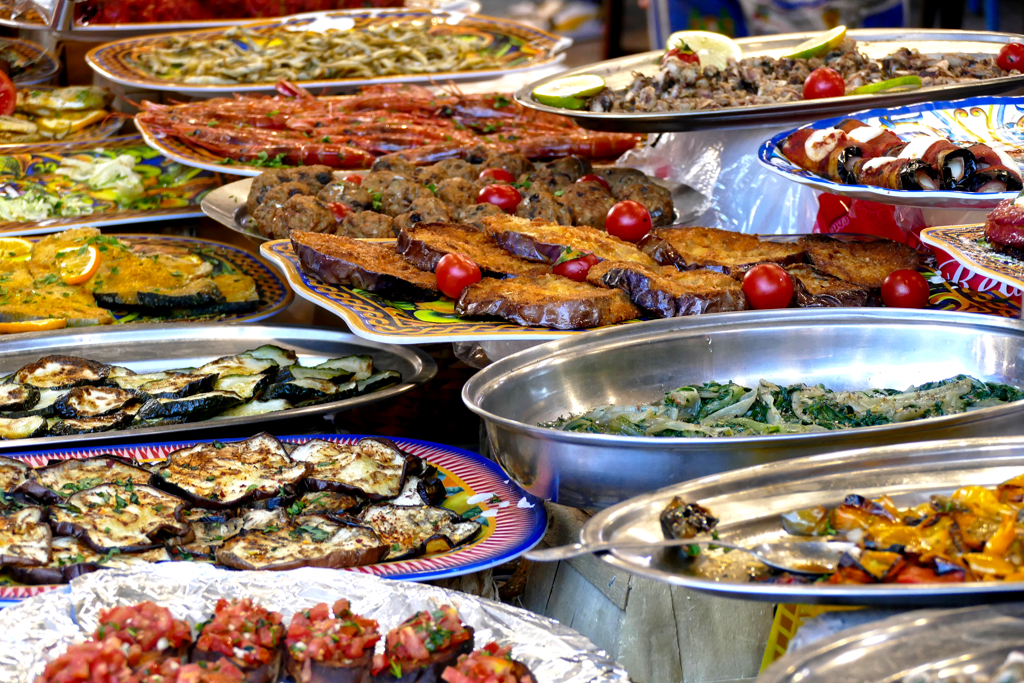
No, the most iconic dish is not pizza, the inalienable staple are Arancini, deep-fried rice balls filled with ragù, hence a juicy meat sauce, cheese, or vegetables. They are the perfect snack and – according to pure bone Sicilians – eating them with a knife and fork is a sacrilege.
Another highly popular fast food is are so-called Panelle. These fritters are made from chickpea flour and are often served in sandwiches.
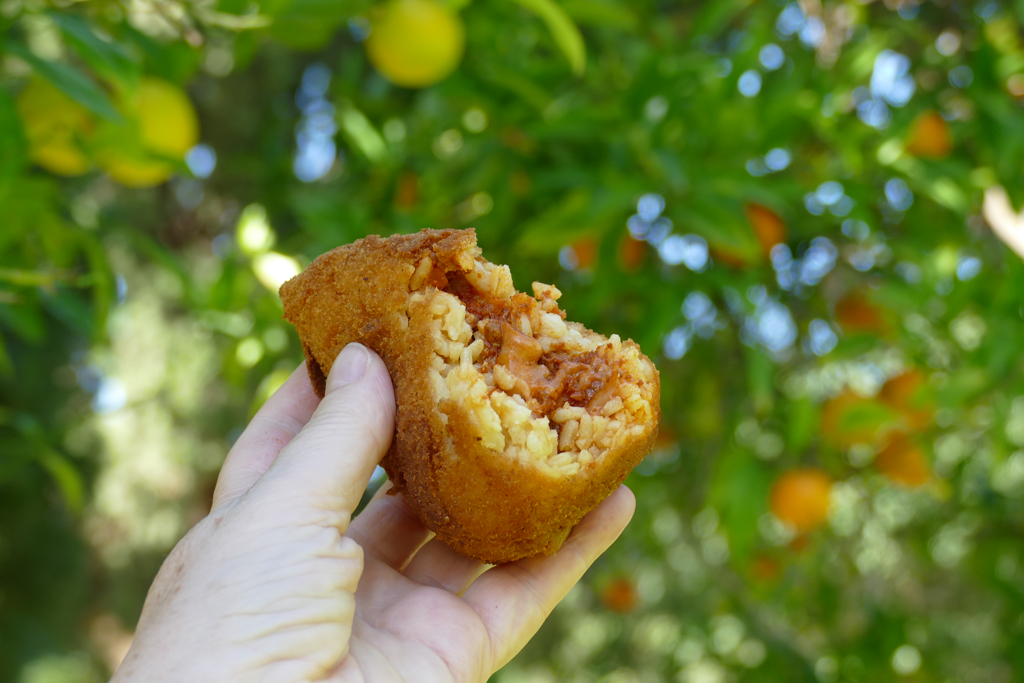
My favorite Sicilian dish is Caponata, a sweet and sour eggplant stew, seasoned with olives, capers, and tomatoes. Add ricotta cheese and basil, and you have a sauce alla Norma that you can pour over pasta or stuff into Arancini. Another incredible pasta sauce is con le Sarde, hence with sardines, but also with fennel, pine nuts, and raisins. This sauce clearly showcases Arab influences in local cuisine.
And yes, there is also pizza. The Sicilian kind is called Sfincione. It is softer and thicker than its Neapolitan counterpart and topped with tomatoes, onions, anchovies, and breadcrumbs.
Bakeries’N’Bars
I have often sung the praises of Italian coffee bar culture. I just love the atmosphere when police officers, students, garbage collectors, and elegant office ladies gather at the counter in the morning for a quick coffee, a pistachio cream-filled croissant, and a friendly chat. Nevertheless, the fact that a classic Italian breakfast doesn’t fill me up is an obvious flaw in the system. Luckily, almost all bars also offer lavish sandwiches and stuffed savory pastries, so I can enjoy those.
Although I don’t really have a sweet tooth, cannoli have conquered my heart – and most importantly my taste buds. This is primarily because they are traditionally filled with only slightly sweetened ricotta cheese. This creamy filling in combination with the crispy coating is simply irresistible.

The other traditional sweets such as Cassata, a decadent layered cake with ricotta, marzipan, and candied fruit, and marzipan fruits just made it onto my souvenir list. They’re pretty and colorful, but the taste isn’t for me.
Cash and Cards
Until now, 20 European countries have replaced their former local currency with the €uro starting in 2002. Obviously, Italy is one of them. The exchange rate is 1 US$ = 0.85 EUR as of August 2025. However, you can check today’s conversion rate on this page.
Mind you paying by card as well as contactless is accepted basically everywhere including regional and local public transport.
Language
Zushini, Gnotchi, Raditcho – I’m bleeding from my ears as I often hear these mispronunciations.
Yet, it’s not that difficult at all. Therefore, here are some general rules.
As in any other Romance language, C and G are hard when written before A, O, and U. Hence, they are pronounced K respectively G like in garment or good.
If followed by E or I, it’s tch as in witch respectively dj as in generation.
Now, if a C or G followed by E or I should be pronounced K or G, an H is added. Bruschetta, Zucchini, Gnocchi, Ghetto become Brusketta, Zukini, Gnoki, Radikio respectively Ghetto .
On the other hand, if C or G followed by A, O, or U should be pronounced tch respectively dj, they slip in a – silent! – I. Ciocolata and Ciabatta become Tchocolata and Tchabatta and Ortigia is pronounced Ortidja. Either way, forget about the I in-between.
Italian Classes in Sicily
As a matter of fact, it might be a great idea to learn some Italian or brush up on what you already know while in Sicily. A great place to do so is for instance the Italian Academy in Syracuse.
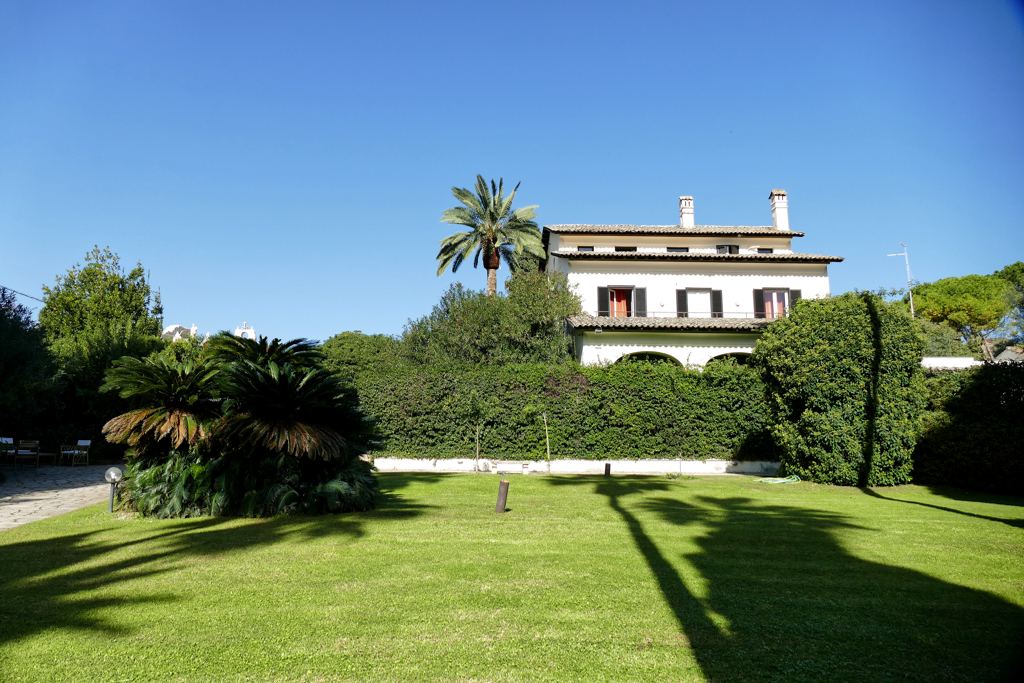
They advertise that they are professional and friendly and I can fully confirm that. I took a two-week intensive course and progressed a whole level in that time. So if you want to completely immerse yourself in Italian life with all your senses, take a look at what the school has to offer.
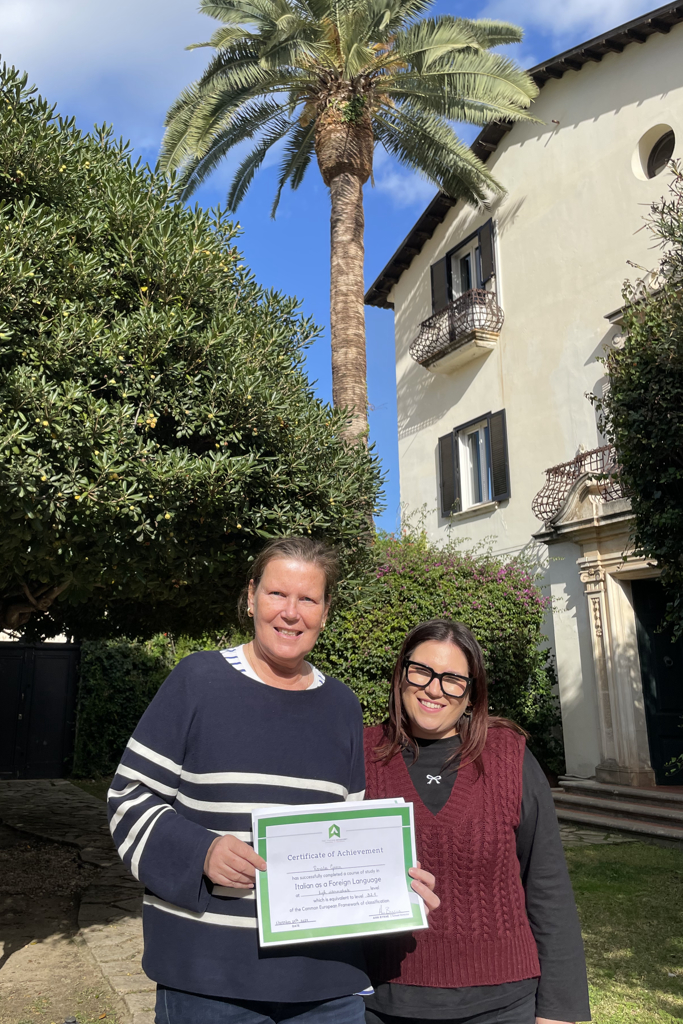
(Photo: Mies Geubels)
If you are interested in taking Italian classes, but you’re insecure about how to organize your stay, don’t worry. The friendly and efficient ladies at the academy’s office are accommodating and can arrange literally everything for you.
After a placement test, they advise you which class would be your best choice and help you with every little detail including providing housing for the duration of your course.
Connection and Communication
Since June 2017, no roaming charges have been applied within the EU with a European mobile phone contract, This applies in all 27 countries of the European Union as well as in Great Britain, Iceland, Liechtenstein, and Norway and to all contracts.
In case European roaming is unavailable, you can connect to the internet without any issue at basically every museum, eatery, café, and, of course, hotel.
If you insist on being online 24/7, you can get a SIM card, obviously. There are prepaid SIM cards by various companies. For non-European travellers visiting Italy, the best SIM cards are Telecom Italia Mobile, in short TIM. It is Italy’s largest mobile operator with excellent coverage and data speeds. Their best plan should be TIM Tourist SIM which supplies you bis 20 GB and 200 minutes to international numbers. It costs around 20 €uros and is valid for 30 days.
A good alternative is Vodafone Italy with their plan Vodafone Holiday. For 30 days, you get 30 GB and 300 minutes for calls including international numbers for around 30 €uros.
Finally, WindTre is a great option for budget-conscious travelers as their WindTre Tourist Pass offers 20 GB and 100 minutes for international and unlimited calls within Italy, all this also for 30 days.
This being said, e-sim cards are the easiest way to stay connected as you arrange everything on the internet.
Get the Power
The standard voltage in Europe is 220 V and the frequency is 50 Hz. In Italy, they use three plug types, namely C, F, and L.
Whereby, since nowadays, all these chargers have integrated adapters, in general, the voltage and frequency don’t really matter. You only need an adapter for small appliances such as curling irons or hair dryers. But keep in mind that at basically every accommodation you will have a hair dryer at your disposal.
You’ll find comprehensive travel info in my post World’s Most Complete Travel Information – an indispensable globetrotter-classic.
Map
On this map, I’m showing you where to find the spots worth visiting during a stay in Syracuse. Clicking on the slider symbol at the top left or the full-screen icon at the top right will display the whole map including the legend.
Syracuse was only one of the various absolutely amazing places I visited during my trip to Sicily. To read about the others, go to this post and take your pick!
Pinnable Pictures
If you choose to pin this post for later, please use one of these pictures:
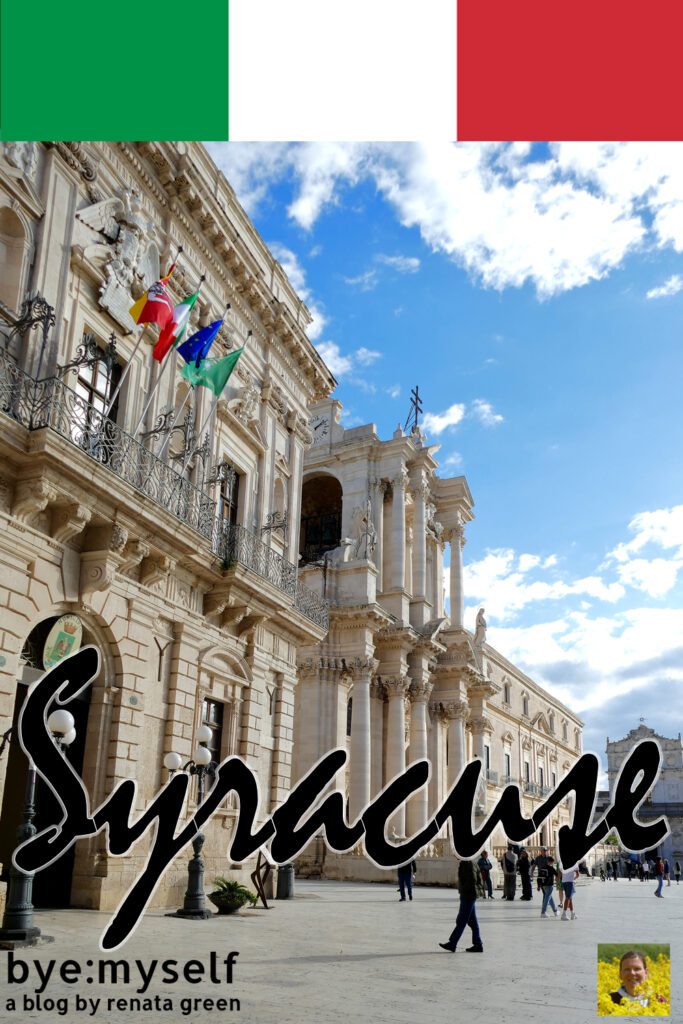
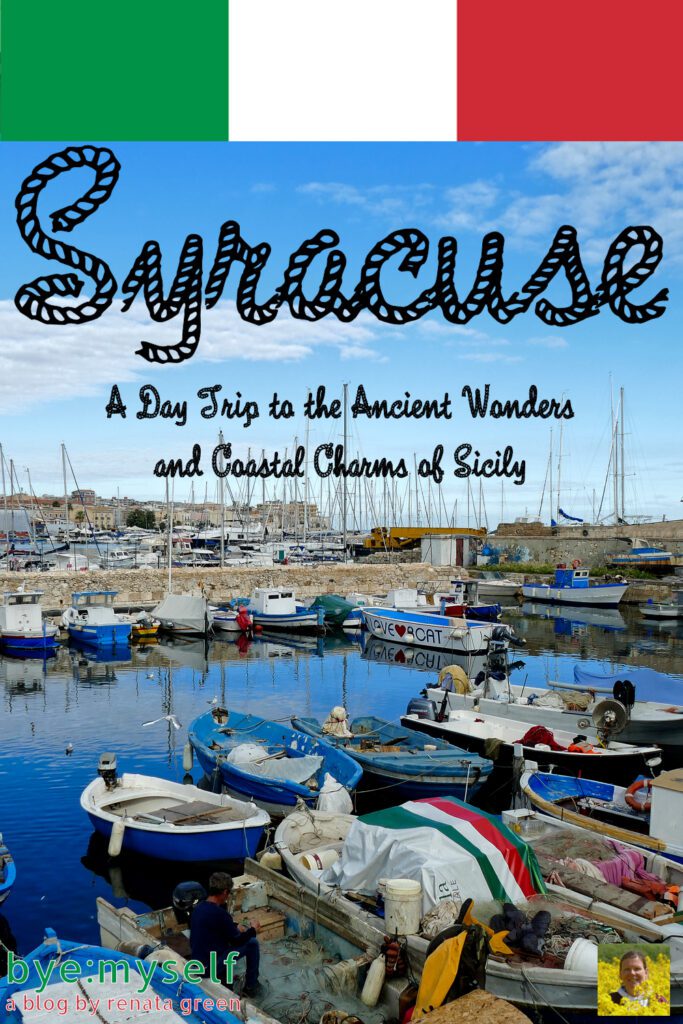
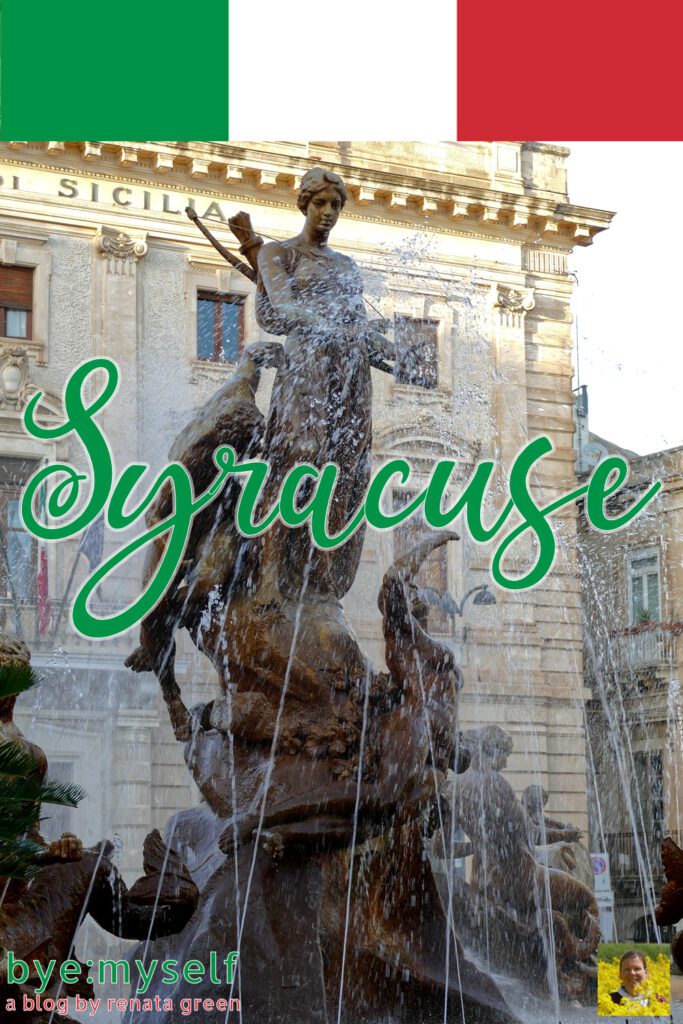
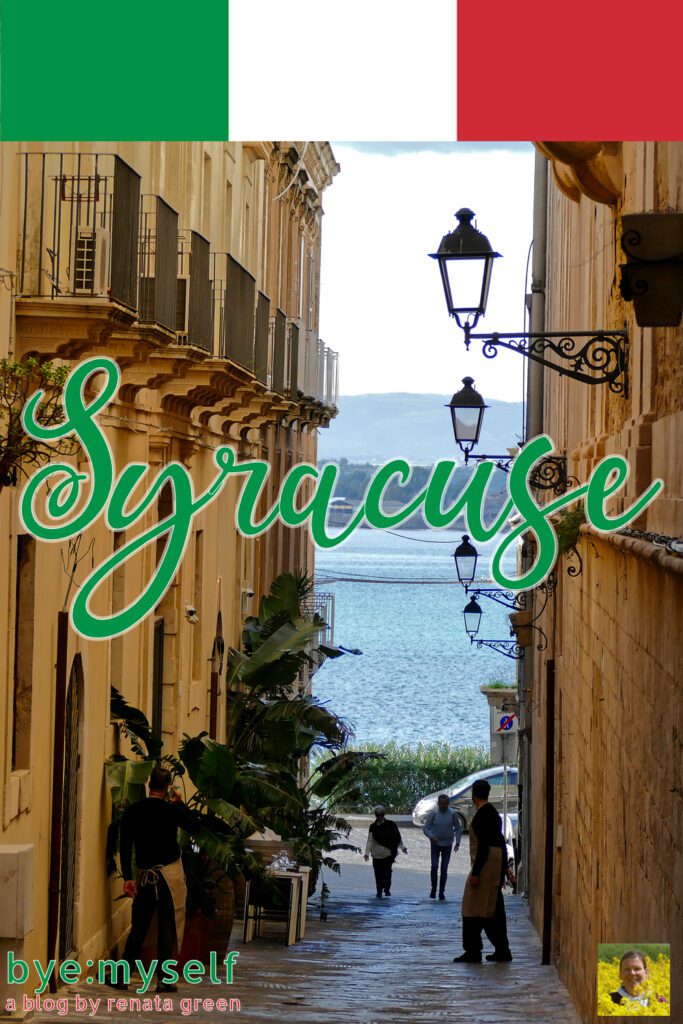
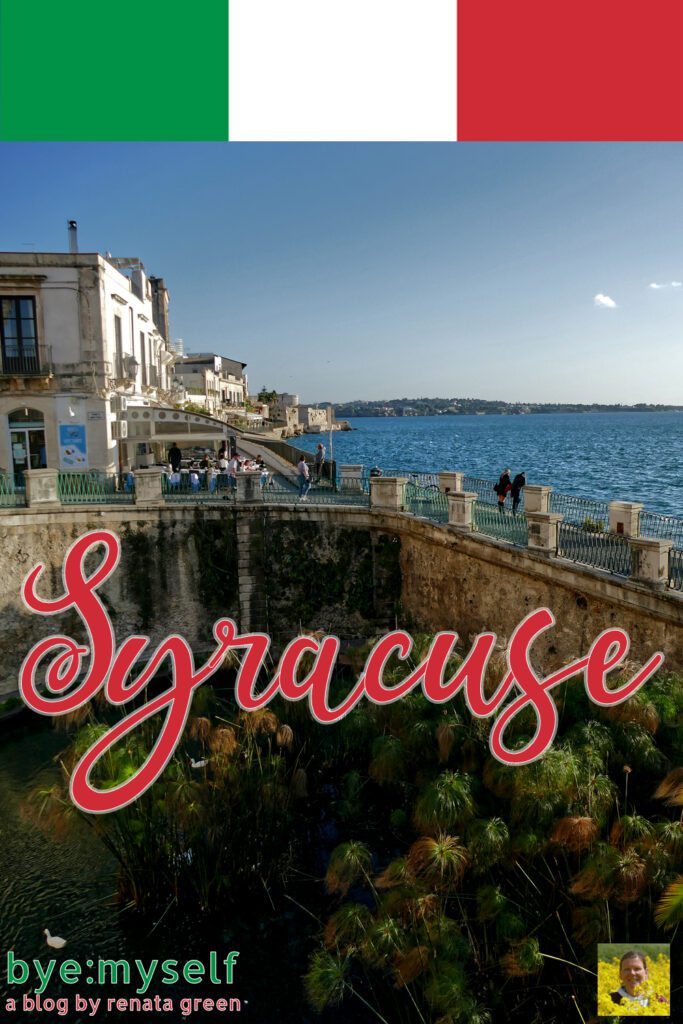
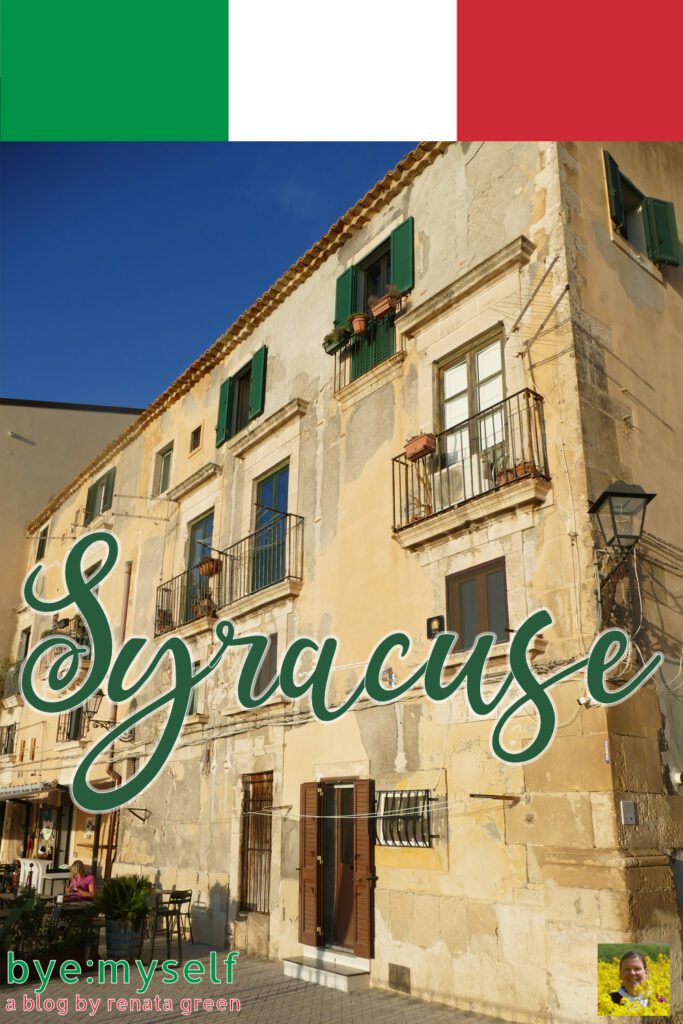
Note: This post is being regularly completed, edited, and updated – last in August 2025.
Did You Enjoy This Post? Then You Might Like Also These:
50 Most Beautiful Palaces in Venice
United Colors of Biennale – Visiting the Biennale di Arte in 2017
Day Trip from Venice to Padua
VENICE on a Budget: When to Go, Where to Stay, What to Eat, And Much More
The Valley of the Temples of Agrigento And La Villa Romana del Casale di Piazza Armerina: A Day Trip Not to Miss
CINQUE TERRE – The World’s Most Picturesque Hiking Trails
Comprehensive Guide to FLORENCE – Home of the Medici, Cradle of the Renaissance
A Day on MURANO: It’s a Crystalline World
* This is an affiliate link. Hence, If you book through this page, not only do you get the best deal. I also get a small commission that helps me run this blog. Thank you so much for supporting me!
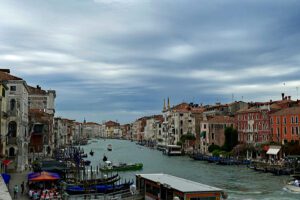

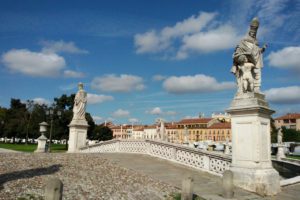
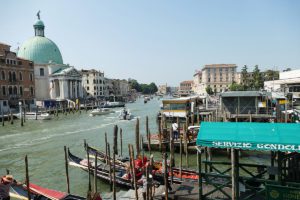
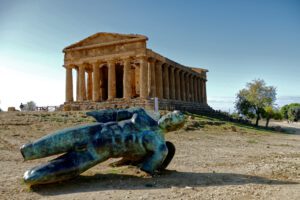
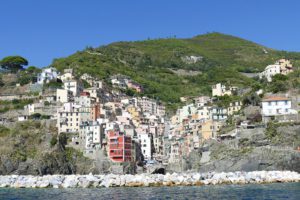
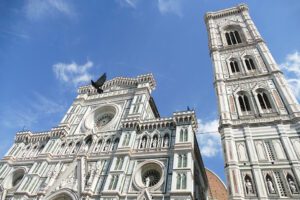
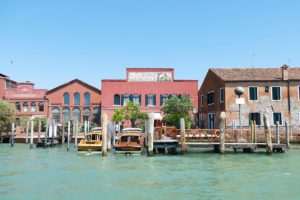
What a fantastic read! I appreciate how you not only covered the must-sees but also dug deeper into some lesser-known spots. Your thorough research and the way you’ve connected the places into a coherent city tour make this a truly comprehensive guide. I’m looking forward to reading more of your work!
Thank you for your kind words – I’m glad my guide to Syracuse is helpful. Happy travels – buon viaggio!